
Most Americans take for granted the federal
government’s role in protecting workers from
injuries that might occur on the job. The popu-
lar notion is that, without the Occupational
Safety and Health Administration and its sister
agency, the Mine Safety and Health
Administration, some companies, perhaps many,
would not invest in safety, which would lead to a
rise in workplace accidents in the United States.
The problem with the popular perception is that
it is based more on faith in beneficent govern-
ment than on facts about government interven-
tion in workplace safety.
Although MSHA has claimed success, there is
no reliable evidence indicating that the Federal
Mine Safety and Health Act of 1977 has made
the nation’s mines any safer. It is actually more
likely that the act’s substitution of rules for
results, of government vigilance for employee
vigilance, and of sanctions for cooperation has
slowed the historic trend toward safer mines.
Despite the questionable benefits bestowed by
the act, special interest groups and MSHA have
successfully defended it against proposals for
reform. As a result, consumers and taxpayers are
left paying the substantial direct and indirect
costs of federal intervention.
The best solution may be to repeal the Mine
Act. Contrary to popular belief, there are sub-
stantial incentives in place that encourage mine
operators to make investments in safety. One of
the most notable incentives is the compensating
wage differentials that miners demand for
undertaking more hazardous work. By respect-
ing the risk-for-pay decisions made by individual
miners, the federal government might be able to
achieve its objective of making the nation’s
mines safer.
Saving Lives or Wasting Resources?
The Federal Mine Safety and Health Act
by C. Gregory Ruffennach
_____________________________________________________________________________________________________
C. Gregory Ruffennach is an attorney specializing in mineral law in Durango, Colorado.
Executive Summary
No. 453
September 19, 2002

We shall not grow wiser before we learn
that much that we have done was very
foolish.
—F. A. Hayek
The 1977 Federal Mine Safety and Health
Act (hereinafter Mine Act), which is rapidly
approaching its 25th anniversary, was passed
by Congress “to provide a more effective
means” of preventing death and serious phys-
ical injury in the nation’s mines.
1
To that end,
the act created a federal law enforcement
scheme consisting of regulation, inspection,
and sanction. The tripartite forced compli-
ance scheme was supposed to be more effec-
tive, not only than its forerunner, the Federal
Coal Mine Health and Safety Act of 1969
(hereinafter Coal Act), but also than the other
federal mining laws that preceded it. Prior to
the 1969 Coal Act, the federal government did
not take a forced compliance approach to
mine safety. Although the Bureau of Mines,
which was created as a federal agency in 1910,
had limited enforcement authority at certain
coal mining operations by 1952, it was pre-
dominantly an informational agency.
The Labor Department, whose Mine
Safety and Health Administration is charged
with implementing the Mine Act, has always
maintained that the forced compliance
approach required by the act has been more
effective than the informational approach
taken by the Bureau of Mines. In fact, former
labor secretary Robert Reich has gone so far
as to hold out the Mine Act as the epitome of
effective government enforcement:
It’s become fashionable lately to dump
on Washington, to say the federal gov-
ernment is just too nosy, too demand-
ing, makes too many rules. The triumph
of the mine safety and health program
serves to remind us of the good that
government can do.
2
Similarly, Davitt McAteer, who held the top
spot in MSHA under the Clinton adminis-
tration, has repeatedly boasted that the Mine
Act is a “scheme that works.”
3
Regardless of whether or not it is fashion-
able to “dump on” the federal government as
Reich contended, it is certainly not fashion-
able to question the federal government’s law
enforcement role in mine safety. As Rep. Cass
Ballenger (R-N.C.), chairman of the House
Subcommittee on Workforce Protections,
noted during a congressional hearing on the
Mine Act in 1998,
I am well aware of the fact that even to
raise these issues is to invite criticism
and demagogue, as being uncaring
about miners, especially underground
coal miners, whose work, I know, is haz-
ardous and difficult.
4
Ballenger was speaking from experience
because, three years earlier, his modest pro-
posal to reform the Mine Act along with the
Occupational Safety and Health Act of 1970
was characterized by organized labor as “the
Workplace Death and Injury Enhancement
Act (DIE Act).”
5
Nonetheless, after more than a quarter of a
century of federal policing of the nation’s
mines, it is appropriate to attempt to deter-
mine whether the Mine Act has provided a
more effective means of preventing miner
deaths and injuries than did the information-
al approach that predated it. The determina-
tion is legitimate not only from a statutory
perspective but also from the larger perspec-
tive of wisely allocating society’s scarce
resources. Although proponents of the Mine
Act often tout its purported lifesaving features
and even attempt to identify specific individu-
als who could have been saved with more vig-
orous enforcement,
6
it is essential to keep in
mind that the resources dedicated to the pro-
tection of adult miners at the workplace are
resources that cannot be used for other pur-
poses, such as preventing the accidental
deaths of children at home. While “we might
all be happier in a world where there were no
such constraints to force us into choices and
trade-offs that we would rather not face,”
7
the
fact of the matter is that, in a world with finite
resources, such tradeoffs are inescapable.
2
Resources
dedicated to the
protection of
adult miners at
the workplace
are resources
that cannot be
used for other
purposes.

Forced compliance has not been more effec-
tive in preventing death and serious physical
injury in the nation’s mines than the policy of
information that preceded it.
8
Since the turn of
the 20th century, fatalities in the nation’s mines
have been steadily declining irrespective of fed-
eral police intervention. In fact, on a fatality per
million ton basis, it appears that the trend
toward fewer fatalities in the coal mines actual-
ly slowed after the forced compliance approach
was introduced.
Although that observation may come as a
surprise to people like Reich, who believe in
the capable beneficence of the federal gov-
ernment, it will not surprise those in the min-
ing industry who recognize that forced com-
pliance does not equate to improved safety.
The Mine Act attempted to resolve a per-
ceived, but probably not real, economic prob-
lem with a legalistic solution. The legalistic
approach, which substituted rules for results,
inspector vigilance for employee vigilance,
and sanctions for cooperation, was inferior,
in every respect, to the informational
approach taken by the Bureau of Mines.
Obviously, a legalistic approach that
yields no measurable benefits in terms of
lives saved while diverting resources from
wealth creation and even safety-related activ-
ities is not the best use of societal resources.
In this regard, the necessary corollary to the
sentiments expressed by Reich is that any
“good that the government can do” is only
good for those who reap the benefits. The
Mine Act benefits Labor Department
employees, organized labor institutions,
large unionized mine operators, and, of
course, attorneys,
9
to the detriment of the
people who might otherwise benefit if those
resources were put to other uses.
Because the Mine Act fails to achieve its
stated objective and squanders society’s
scarce resources, Congress should repeal, or
at least significantly amend, it.
10
In the
absence of federal policing, responsibility for
the safety of the nation’s mines would fall on
American society, state and local govern-
ments, and ultimately the individuals who
make up the mining industry. In the event
that there is a demonstrated market failure
once the forced compliance approach is
abandoned, the federal government should
limit its role to the tried and true approach of
providing information and, perhaps, creating
monetary incentives for additional invest-
ments in workplace safety. However, law
enforcement, in the limited circumstances in
which it is appropriate, should be left to local
authorities, which are accountable to the
communities that they serve.
The Emotional Origin of
Safety Regulation
The origin of federal police intervention
in the nation’s mines was, in large part, the
November 1968 explosion in Farmington,
West Virginia, that fatally injured 78 coal
miners.
11
Unfortunately, the Farmington
explosion was not the first or even the worst
coal mine disaster in our nation’s history.
According to MSHA, “the deadliest year” in
U.S. coal mining history was 1907, when
3,242 deaths occurred and a single mine
explosion killed 358 people near Monongah,
West Virginia.
12
Despite the tragic number of
deaths, mine disasters, such as Farmington
and Monongah, were not even the largest
contributors to the loss of life in the nation’s
coal mines.
13
The Farmington disaster was special
because it was the first mining disaster that
received nationwide media coverage.
According to one account, “The resolution of
the disaster . . . played out in the living rooms
of America” and “created a media circus that
would measure up to anything generated
since.”
14
Congress, responding in large part to the
publicity that the disaster received, convened
hearings on coal mine safety and health. The
focus of the congressional hearings was not
on the testimony of safety professionals,
actuaries, statisticians, and economists but
on the testimony of “daughters and wives” of
coal miners who had perished in the
Farmington mine.
15
Such emotional testimo-
3
Forced compli-
ance has not been
more effective in
preventing death
and serious phys-
ical injury in the
nation’s mines
than the policy of
information that
preceded it.

ny may have been appropriate to help a griev-
ing nation, but it was not an appropriate
foundation for a national workplace safety
and health policy, which it ultimately
became.
The Basic Economics of
Safety
Before 1969 the federal government had
taken, for the most part, a market-based
approach to mine safety.
16
In a market-based
approach, prices, which represent the prefer-
ences and values of individuals, are allowed
to determine how much of society’s scarce
resources are dedicated to mine safety.
17
The most obvious and important price
affecting the amount of resources committed
to mine safety is the price that a mine operator
must pay for mine labor. The price of mine
labor reflects, among other things, the risk
preferences of the available labor pool.
18
Where the individuals in the labor pool are
adverse to threats to life and limb, they will
either demand additional compensation, in
terms of pay or benefits, for hazardous jobs or
simply refuse to undertake such work.
19
The “risk premium” that a mine operator
must pay to attract an entire workforce of min-
ers to the mine and keep them there creates an
incentive for the operator to make the mine
safer.
20
Generally, when the price of risk premi-
ums paid to miners exceeds the price of adding
a safety practice or device, a mine operator will
invest in improvements to make the mine safer
in order to avoid paying more for labor.
21
Although research has not revealed any
studies that document the amount of differ-
ential compensation that miners receive for
agreeing to undertake more hazardous work,
it is worth observing that miners are better
paid than nearly all other workers.
22
According to the Bureau of Labor Statistics:
Average earnings in mining and quar-
rying were significantly higher than
the average for all industries. Workers
in underground mines also tend to
earn more per hour than miners on the
surface.
23
The National Mining Association boasts that
“the average miner makes $49,000 per year in
salary, not including overtime, bonuses and
benefits.”
24
Although the price of labor reflects the
risk preferences of individual miners more
than any other price, it is not by any means
the only price that encourages a mine opera-
tor to commit resources to mine safety. As
present MSHA administrator David Lauriski
has noted, “The cost of the average lost work
injury in mining could be on the order of
$10,000 to $30,000 per incident.”
25
The costs
for accidents resulting in injury arise from
investigating and reporting injuries, giving
first aid, losing production, training replace-
ment workers, and paying overtime to unin-
jured workers.
26
Those accident costs create a
strong incentive for a mine operator to com-
mit resources to injury prevention.
27
The price of insurance also creates a sub-
stantial incentive for a mine operator to invest
in accident prevention.
28
In all 50 states, mine
operators are required to maintain workers’
compensation insurance.
29
To a large extent,
the mine operator’s incentive to avoid the insur-
ance costs associated with compensable injuries
is a surrogate for the historical incentive to
avoid tort liability.
30
However, even with the tort
liability protections that state workers’ com-
pensation programs provide, the possibility of
liability to third parties, and even to employees
in certain cases, creates an additional incentive
for mine operators to prevent injuries to
employees.
31
In addition to prevention efforts,
employers generally mitigate those additional
potential liabilities with supplemental insur-
ance. To the extent that workers’ compensation
and supplemental insurance premiums are
experience rated,
32
they create an incentive for a
mine operator to invest in safety.
33
In addition to the direct incentives that a
mine operator has for avoiding injury to its
employees, a mine operator also has an incen-
tive to protect its equipment and facilities.
34
In
the mining industry, which is subject to fire,
4
The “risk premi-
um” that a mine
operator must
pay to attract an
entire workforce
of miners to the
mine and keep
them there creates
an incentive for
the operator to
make the mine
safer.

explosion, and ground failure risks, the costs of
an accident can be extraordinary because of the
equipment and facilities that are sometimes
destroyed.
35
Although losses of equipment and
facilities are generally covered by insurance, the
insurance, to the extent that it is experience
rated, does not reduce the mine operator’s
incentive to focus on loss prevention. More
often than not, the measures that reduce risk to
equipment and facilities have the corollary ben-
efit of reducing risk to miners.
The Informational
Approach to Safety
Regardless of whether its actions were
shaped by principle, political necessity, or inad-
vertence, the federal government’s initial foray
into mine safety focused on improving the mar-
ket for mine safety with information rather
than on displacing the market with police inter-
vention. In 1910 Congress established the
Bureau of Mines as an agency within the
Department of the Interior.
36
The bureau was
“an informational agency,” charged with con-
ducting research and reducing accidents.
37
The
bureau attempted to improve mine safety
through the dissemination of information to
both miners and mine operators.
38
Economic theory, which holds that “better
information can improve the workings of the
market for safety,” predicts that the bureau’s
efforts to disseminate information would
improve safety in the mines.
39
Information is
essential to the proper functioning of the mar-
ket for safety because the risk premiums
demanded by “informed workers merit more
respect than those of uninformed workers.”
40
If
a miner does not recognize and understand the
hazards that he faces at the mine site or erro-
neously assumes that he is exempt from risk,
41
he may not demand an adequate risk premium
from the mine operator. An inadequate risk
premium does not create a sufficient incentive
for the mine operator to invest in safety.
Despite the fact that it is essential to
informed decisionmaking, information has
deviant properties as a market good, which
means that in unregulated markets for safety
there may not be appropriate incentives to
develop and share information.
42
With
respect to the development of safety infor-
mation, Rhea Graham, former director of the
Bureau of Mines, explained,
In these areas [workplace safety and
health], the returns to society [based on
research and development] may be
large, but the returns to the individual
or private company may not be suffi-
cient to encourage investment.
43
For example, although coal mine explosions
accounted for significant loss of life and capital
in the first part of the 20th century, it was the
Bureau of Mines, not mine operators, that
established through study and experimenta-
tion that coal dust contributed as much to the
explosion problem as did methane and that
rock dusting was an effective preventive mea-
sure.
44
With respect to the sharing of safety
information, mine operators with poor safety
records have little incentive to share hazard
information with miners who might demand
higher wages.
45
The Bureau of Mines attempted
to fill the employee information gap, for exam-
ple, by distributing 352,000 “Miner’s Circulars”
to coal miners in 1912.
46
Although research has not revealed any
analysis that shows a statistically significant
correlation between the bureau’s dissemina-
tion of information and an improvement of
safety in the nation’s mines, Figure 1 shows
that after the bureau’s creation the number
of mine fatalities began a steady descent that
has only recently tapered off.
Although the correlation does not establish
that the Bureau of Mines contributed to the
decline in mine fatalities, specific instances in
which information disseminated by the bureau
directly and positively affected mine safety have
been well documented.
47
Congress granted the bureau greater
authority in the years following its creation,
48
but the bureau’s enforcement authority at coal
and noncoal mines remained minimal.
49
In
1941 the bureau was authorized to enter coal
5
Measures that
reduce risk to
equipment and
facilities have the
corollary benefit
of reducing risk
to miners.
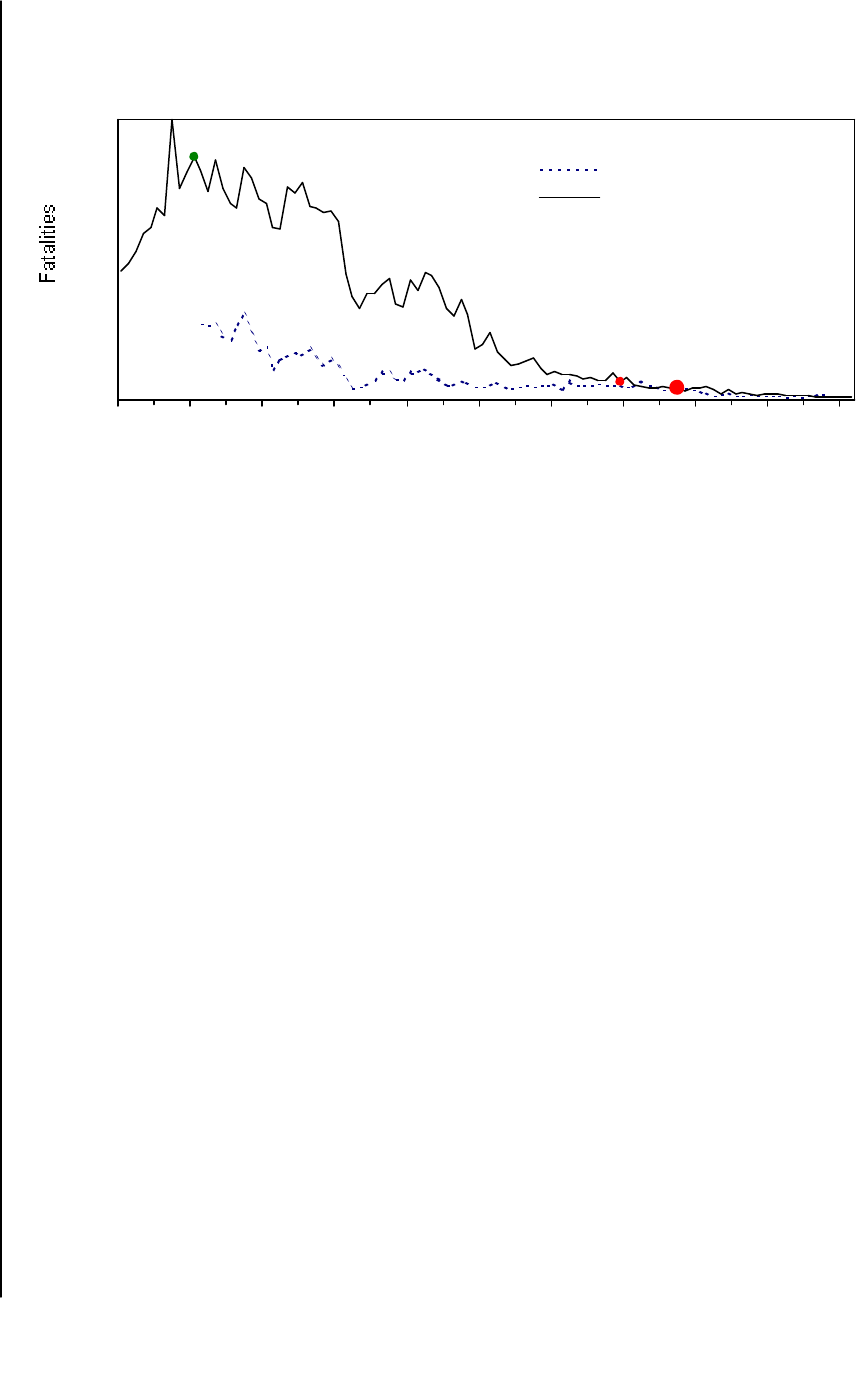
mines, and in 1947 it was authorized to formu-
late a code of federal advisory regulations for
mine safety. The Federal Coal Mine Safety Act
of 1952, which was amended in 1966, and the
Federal Metal and Nonmetallic Mine Safety Act
of 1966 provided for the promulgation of
mandatory standards, inspection and investiga-
tion authority, and the issuance of violation
notices and withdrawal orders. However, under
both acts the imposition of civil sanctions was
limited to cases in which an inspector had been
refused access to a mine or in which there was
noncompliance with an inspector’s withdrawal
order. For the most part, the federal govern-
ment left law enforcement at mining opera-
tions to the individual states.
50
The Illusion of Resource
Misallocation
To a large extent, the 1969 Congress still
considered the problems with mine safety, as
exemplified by the Farmington disaster, to be
economic in nature. Specifically, Congress
determined that the mining industry did not
properly allocate its capital and human
resources. The 1969 Congress explained: “The
way that we mine coal today is not humanitari-
an, resourceful, or efficient. It is inexcusably
wasteful of our most precious asset—the
human being.”
51
Despite the numerous terrible coal mine
disasters that preceded passage of the Coal
Act, it is unlikely that coal mine operators
viewed labor as a resource that was abundant
enough to be wasted in 1969. As Figure 2
illustrates, since at least 1950 the coal mining
industry in the United States had been pro-
ducing more tonnage with fewer miners.
The trend suggests, contrary to congres-
sional views in 1969, that coal mine opera-
tors treated mine labor as a scarce resource
that needed to be conserved.
Nowhere is the conservation of coal mine
labor in the United States more evident than in
a comparison between coal mining in China
and in the United States. In China, where labor
is abundant and capital is scarce, it is estimated
that around 20,000 coal miners were fatally
injured while producing about 1.2 billion tons
of coal in 1999.
52
In the same year, in the United
6
The trend sug-
gests, contrary to
congressional
views in 1969, that
coal mine opera-
tors treated mine
labor as a scarce
resource that
needed to be
conserved.
Figure 1
Annual U.S. Mining Fatalities
Sources: Author’s calculation (metal/nonmetal fatalities = coal fatalities) based on data from U.S. Department of
Labor, MSHA Internet, Metal/Nonmetal Fatalities 1900 [1911] through 2001, www.msha.gov/centurystats/mnm
stats.htm; and U.S. Department of Labor, MSHA Internet, Coal Fatalities for 1900 through 2001, www.msha.gov/
centurystats/coalstats.htm.
Coal Act
Mine Act
0
250
500
750
1,000
1,250
1,500
1,750
2,000
2,250
2,500
2,750
3,000
3,250
1900 1910 1920 1930 1940 1950 1960 1970 1980 1990 2000
Metal/Nonmetal
Coal
Year
Bureau of Mines

States, where capital is abundant and labor is
scarce, only 29 miners were fatally injured while
producing approximately 1.1 billion tons of
coal.
53
Thus, it appears that the resource allocation
issue that Congress was determined to address
in 1969 may not have been as bad as Congress
made it out to be, if it existed at all. In 1969, 203
coal miners died producing 570,670 thousand
tons of coal; whereas 35 years earlier, in 1934,
1,226 coal miners died producing 416,166
thousand tons of coal.
54
Although Congress
heard it otherwise, the clear trend, for whatever
reasons, was toward conserving the lives of coal
miners.
55
The New Regulatory Road
Ironically, although the 1969 Congress
characterized the problem as one of resource
allocation, it did not opt for an economic
solution to the perceived problem. Instead,
Congress and the Nixon administration,
both of which consisted of more lawyers than
economists, determined that “a strong law is
necessary to protect the men who extract one
of our Nation’s most vital resources.”
56
The
“strong law” was, of course, the 1969 Coal
Act, which put in place a law enforcement
scheme of regulation, inspection, and sanc-
tion for the nation’s coal mines. The Coal Act
assigned “legal rights and duties,” placing the
“duty” to maintain a safe workplace on the
coal mine operator and granting the “right”
to a safe workplace to the coal miner.
57
The 1969 Congress charged the Bureau of
Mines with implementing the new assignment
of safety duties and rights within the nation’s
coal mines. In 1973 the Department of the
Interior transferred the bureau’s new enforce-
ment functions to the Mine Enforcement
Safety Administration.
58
The enforcement pow-
ers transferred to MESA, which at the time of
7
It appears that
the resource allo-
cation issue that
Congress was
determined to
address in 1969
may not have
been as bad as
Congress made it
out to be, if it
existed at all.
Figure 2
Conservation of Coal Mine Labor
Sources: Number of miners based on U.S. Department of Labor, MSHA Internet, Coal Fatalities for 1900 through
2001, www.msha.gov/centurystats/coalstats.htm; coal production based on data from Energy Information
Administration, Coal Products Publications, Coal Data: A Reference, Table 18, U.S. Production Trends in
Bituminous Coal and Lignite, 1900–1993 (total production, thousand short tons), 1995, pp. 65–66,
http://tonto.eia.doe.gov/FTPROOT/coal/006493.pdf; Pennsylvania Department of Environmental Protection,
Mining and Reclamation, 2000 Annual Report on Mining Activities, Table 1, Anthracite Statistical Summaries
1870 to 2000 (production, net tons), www.dep.state.pa.us/dep/deputate/minres/bmr/annualreport/2000/
table_01.htm (1990 to 1993 anthracite production data); and Energy Information Administration, Coal Products
Publications, Coal Industry Annuals 1994–2000 (thousand short tons), http://tonto.eia.doe.gov/FTPROOT/
coal/coalpubs.htm (1994–2000 coal production data, including Pennsylvania anthracite operations but excluding
silt, culm, refuse bank, slurry dam, and dredge operations).
0
100,000
200,000
300,000
400,000
500,000
600,000
700,000
800,000
900,000
1,000,000
19001905 191019151920 1925 1930 19351940 194519501955 1960 1965 1970 1975 198019851990 19952000
0
200
400
600
800
1,000
1,200
Year
U.S. Coal Miners
U.S. Coal Production

enactment were unique to the Coal Act, includ-
ed the imposition of monetary penalties for all
violations of mandatory federal coal safety and
health standards as well as criminal penalties
for knowing and willful violations of the stan-
dards.
59
The use of “first-instance” sanctions
marked a significant departure from prior fed-
eral policies,
60
which left law enforcement to the
various states and, to a large extent, left mine
safety to the economic marketplace.
Unfortunately, passage in 1969 of the Coal
Act with its forced compliance approach did
not put an end to disasters in the coal mining
industry. As Congress noted in 1977:
At Buffalo Creek, in February, 1972,
125 persons died when a dam burst
sending a near tidal wave of murky
water through the seventeen mile long
valley, while the mining enforcement
agency questioned its authority to reg-
ulate the coal mine impoundment
dam in question.
At Blacksville, in July 1972, nine min-
ers at work behind a piece of equipment
that caught fire were trapped and died in
the mine because those at the scene of the
fire had not been adequately trained in
emergency procedures.
At Scotia, in March, 1976 twenty-
three miners and three Federal inspec-
tors died in two explosions of accumu-
lated methane gas when the mine safety
enforcement effort was unable to detect
and address chronic conditions of inade-
quate ventilation in that mine.
Near Tower City, Pennsylvania, in
February, 1977, nine miners died when
water from an underground source
inundated active workings, sending tons
of water and debris coursing through the
mine.
61
On the basis of those tragedies, the 1977
Congress concluded that “review of . . . six years
of enforcement of the Coal Act, requires the
Committee to report that fatalities and dis-
abling injuries in our nation’s mines are still
unacceptably and unconscionably high.”
62
Having reached that conclusion, the 1977
Congress did not deduce that forced compli-
ance might not meaningfully improve work-
place safety; rather it surmised that a more
stringent law with broader coverage was
required. The 1977 Congress reasoned that
mine operators [must] still find it
cheaper to pay minimal civil penalties
than to make the capital investments
necessary to adequately abate unsafe or
unhealthy conditions. . . .
63
Following that curious reasoning, the 1977
Congress resolved to “strengthen” the 1969
Coal Act.
The Special Interest
Influence
Before the Mine Act was passed in 1977, the
Coal Act provided protection to only the nation’s
coal miners. Congress had determined that “coal
miners deserve the safest, healthiest work envi-
ronment our technology will enable us to pro-
vide,” but it did not make a similar determina-
tion with respect to noncoal miners.
64
However, as is often the case when one
group gets special treatment from the govern-
ment,
65
other groups soon demanded similar
treatment.
66
True to that principle and seven
years after the enactment of the Coal Act, the
United Steelworkers of America complained
that “there is absolutely no reason why miners
in one segment of the mining industry should
be given different statutory rights than miners
in another segment of the industry.”
67
After all,
the May 1972 carbon monoxide asphyxiation
of 91 miners at Sunshine Silver Mine in Idaho
demonstrated, quite horrifically, that death in
the workplace was not unique to coal miners.
68
Actually, there were valid reasons to treat
underground coal miners differently than
other groups of miners. In 1977 underground
anthracite coal miners had significantly higher
injury incidence rates than did all other types of
miners.
69
Nevertheless, organized mine labor
was able to convince Congress that the
8
There were valid
reasons to treat
underground coal
miners differently
than other groups
of miners.

strengthened scheme of regulation, inspection,
and sanction should be extended to all min-
ers.
70
Some scholars opined that, to a large
extent, organized mine labor used the legisla-
tive process to achieve what it had been unin-
terested in achieving
71
at the bargaining table.
72
Thus, with passage of the Mine Act in 1977,
Congress provided special protections for “the
sacred lives of those members of our society
who toil in the mines to keep our country run-
ning efficiently.”
73
However, Congress afforded
less extensive protections under the
Occupational Safety and Health Act of 1970 for
other American workers who toiled in the fac-
tories, fields, and forests to keep our country
running efficiently, despite the fact that some
of those workers were exposed to greater work-
place hazards than even underground
anthracite coal miners.
74
The Neglected
Constitutional Constraints
To a certain extent, however, Congress was
powerless to protect the lives of all miners at the
behest of the labor organizations. The U.S.
Constitution expressly enumerates the powers
of the federal government. One cannot find
among those enumerated powers a power to
police the nation’s mines, or any workplace for
that matter. Though Congress’s intentions to
protect sacred human life were honorable, the
Tenth Amendment of the Constitution
reserves such police powers to the individual
states.
75
The Constitution, however, does grant
Congress the power “to regulate commerce.”
76
Thus, when Congress initially resolved to pro-
tect the lives of coal miners in 1969, it declared,
[T]he disruption of production and the
loss of income to operators and miners
as a result of coal mine accidents or occu-
pationally caused diseases unduly
impedes and burdens commerce.
77
The 1969 declaration was not without prece-
dent or context. In 1940 the federal govern-
ment actually seized the nation’s coal mines to
avert a labor dispute that might have disrupt-
ed the supply of coal during a period of
increasing hostility abroad.
78
In 1969, at the
dawn of the so-called energy crisis, America
was facing concerns about future energy sup-
plies.
79
Even in that historical and geopolitical
context, the specific nexus between interstate
commerce and particular coal mine disasters
was not entirely clear.
The nexus was even less clear in 1977
when Congress expanded the Coal Act to
cover noncoal mines.
80
The reality, in 1977
and even in 1969, was that Congress was
enacting social measures aimed at minimiz-
ing “the grief and suffering of miners and
their families” at the behest of labor organi-
zations and was not especially concerned
about commerce between the states.
81
The Forced Compliance
Approach
Echoing the concerns about resource alloca-
tion first raised in 1969, the “first priority” of
the Mine Act was to establish the miner as the
mining industry’s “most precious resource.”
82
The 1977 Congress, however, did not opt to
increase the value of the miner through eco-
nomic means, such as a tax on injuries.
83
Instead, the 1977 Congress, following the lead
of the 1969 Congress, attempted to protect
miners by granting them legal rights, specifical-
ly “the right to a safe workplace.”
84
To ensure that the right of miners to a safe
workplace was vigorously protected, the 1977
Congress moved MESA from the Department
of the Interior to the Department of Labor and
renamed it the Mine Safety and Health
Administration. Historically, the Department
of Labor, which housed the Occupational
Safety and Health Administration, had been
the governmental entity charged with protect-
ing federal rights granted to workers.
85
MSHA was charged with implementing a
tripartite forced compliance scheme, similar to
but more stringent than the scheme created by
the 1969 Coal Act. First, Congress directed
9
The U.S.
Constitution
expressly enu-
merates the pow-
ers of the federal
government. One
cannot find
among those enu-
merated powers a
power to police
the nation’s
mines, or any
workplace for
that matter.

MSHA to promulgate mandatory safety and
health standards for all of the nation’s mines.
86
Second, Congress required MSHA to enter all
surface mines at least twice a year and all under-
ground mines at least four times a year, without
warrant or notice, to assess compliance with the
federal standards.
87
Third, Congress directed
MSHA to penalize any and all instances of non-
compliance through the use of first-instance
civil fines and criminal sanctions, not only
against mine operators but also against direc-
tors, officers, and agents of mining corpora-
tions as individuals.
88
In passing the Mine Act, the 1977
Congress did not intend the forced compli-
ance approach to augment the market-based
approach that predated the 1969 Coal Act;
rather, Congress intended police interven-
tion to supplant the market for safety. The
1977 Congress believed that its attempt to
eliminate the hazards associated with mining
through forced compliance would be so suc-
cessful that it would actually reduce the labor
costs,
89
injury or downtime costs,
90
and
workers’ compensation costs
91
that had tra-
ditionally created incentives for mine opera-
tors to invest in safety. Simply put, Congress
fully expected forced compliance
[t]o provide more effective means and
measures for improving the working
conditions and practices in the
Nation’s coal and other mines in order
to prevent death and serious physical
harm, and in order to prevent occupa-
tional diseases from originating in
such mines.
92
The Mine Act was supposed to be “more effec-
tive” than not only the Coal Act but also the
market-oriented, informational approach to
mine safety that existed prior to 1969.
The Mine Act Touted as a
Model Law
In 2000, in MSHA’s annual budget request,
Davitt McAteer, former MSHA administrator,
told Congress that “the Federal Mine Safety
and Health Act has been an extraordinarily effec-
tive law.”
93
McAteer did not cite any studies
that established the effectiveness of the Mine
Act to support his sweeping conclusion.
94
In
fact, he offered only one statement that could
arguably be construed as support for his bold
claim of effectiveness:
I am proud to say that the last five years
have been the safest on record for the
U.S. mining industry. It entered the
20th century with the worst safety and
health industrial record in this country
or abroad—we enter this century with
the best mine safety and health record
among major producing countries in
the world, a proud accomplishment.
95
Presumably, because the U.S. mining industry
went from “worst” to “best” in the 20th centu-
ry, Congress was expected to infer that the
Mine Act had been “extraordinarily effective.”
The Labor Department has not always been so
bashful. In 1995, for example, Labor Secretary
Reich told Congress that “coal miners are five
times less likely to be killed on the job than
they were in 1969, and metal miners twice less
likely to die—largely because we had the Mine
Act and MSHA in place.”
96
In fact, Clinton administration Labor
Department officials were so enamored with
the Mine Act’s forced compliance approach
that they vigorously defended it against reform
in the mid-1990s. In 1995 Congress, lead by
Rep. Cass Ballenger, appeared to be ready to test
the waters with a modest reduction of MSHA’s
enforcement authority, justified on cost-cut-
ting grounds, as part of the Republican Party’s
Contract with America.
97
However, the Labor
Department vigorously defended the statute as
originally enacted in 1977. McAteer told
Congress:
The dramatic improvements in mine
safety and health are proof that the Mine
Act and MSHA are working. We do not
claim sole credit for the success of the last
twenty-five years. . . . There are many fac-
10
In passing the
Mine Act, the
1977 Congress
intended police
intervention to
supplant the mar-
ket for safety.

tors that help explain why things have
improved. It is clear, however, that without
federal intervention, conditions in the mines
would not have improved.
98
The Labor Department, which was support-
ed by organized labor
99
and even by some
large mine operators, successfully defeated
the reform initiative with the help of a veto
threat from President Clinton.
100
Oddly, the 1995 Congress, still in its cost-
cutting mode, subsequently decided to elimi-
nate the Bureau of Mines, which, unlike
MSHA, did not have police powers.
101
At the
time the bureau was eliminated, there were
legitimate questions about whether large min-
ing entities had sufficient incentive and capital-
ization by the end of the 20th century to con-
duct safety research and development on their
own and about whether such research is more
appropriately conducted at universities.
102
Nonetheless, the renewed commitment to
MSHA’s forced compliance approach at the
apparent expense of the Bureau of Mines’ infor-
mational approach, without closer examina-
tion of the actual effects of the different
approaches,
103
raises the question of whether
the priority of the Congress and President
Clinton was the safety of the nation’s miners or
the appeasement of their special interest con-
stituents.
104
In addition to successfully defeating reform
of the Mine Act, Clinton administration Labor
Department officials actually worked to
expand its reach. Then–secretary of labor Reich
told Congress, “All workers should enjoy the
gains in safety and health achieved for miners
by MSHA and the Mine Act.”
105
In this regard,
it is worth noting that for the last 25 years
MSHA has been expanding its jurisdiction to
workplaces that would not traditionally have
been considered mines.
106
MSHA has even pushed the forced com-
pliance approach beyond the boundaries of
the United States and its territories. On
January 10, 2001, President Clinton signed
the International Labor Organization’s
Convention 176, which is based on the prin-
ciples embodied in the Mine Act.
107
With the
signing, then–secretary of labor Alexis
Herman commented:
Ratification of Convention 176 signals
U.S. commitment to safety and health
protection for workers in one of the
world’s most dangerous occupations. . . .
I would like to commend the Mine Safety
and Health Administration’s former
assistant secretary, Davitt McAteer, the
United Mine Workers of America, and
the National Mining Association for
their work in negotiating Convention
176. . . . Convention 176 reflects that
experience and helps to strengthen labor
standards worldwide.
108
According to McAteer, who visited Ukraine on
MSHA business in 1999, Convention 176 “is
just one aspect of our growing involvement in
international activities.”
109
The Truth about the Mine Act
Before providing all workers in the United
States with Mine Act–type protections and
before pushing the legislative model abroad,
it is fair and necessary to ask whether the
Mine Act has provided a “more effective”
means of preventing death and serious injury
than did the federal policy of no police inter-
vention that preceded it. With all due respect
to McAteer, “the dramatic improvement in
mine safety” is not “proof that the Mine Act
and MSHA are working.” The declining
number of fatalities and the declining fatali-
ty rates provide little, if any, information
about whether MSHA has improved the safe-
ty of miners in the last 25 years.
110
In fact, it is disingenuous for MSHA to
claim success on the basis of the favorable
trends in mine safety
111
because, as Figure 1
clearly shows, the trends did not begin in
1977 with the enactment of the Mine Act or
even in 1969 with the enactment of the Coal
Act. The fact that mining fatalities, in
absolute numbers, or even on a rated basis,
have continued to decline after federal inter-
11
It is disingenuous
for MSHA to
claim success on
the basis of the
favorable trends
in mine safety
because the
trends did not
begin in 1977
with the enact-
ment of the Mine
Act or even in
1969 with the
enactment of the
Coal Act.
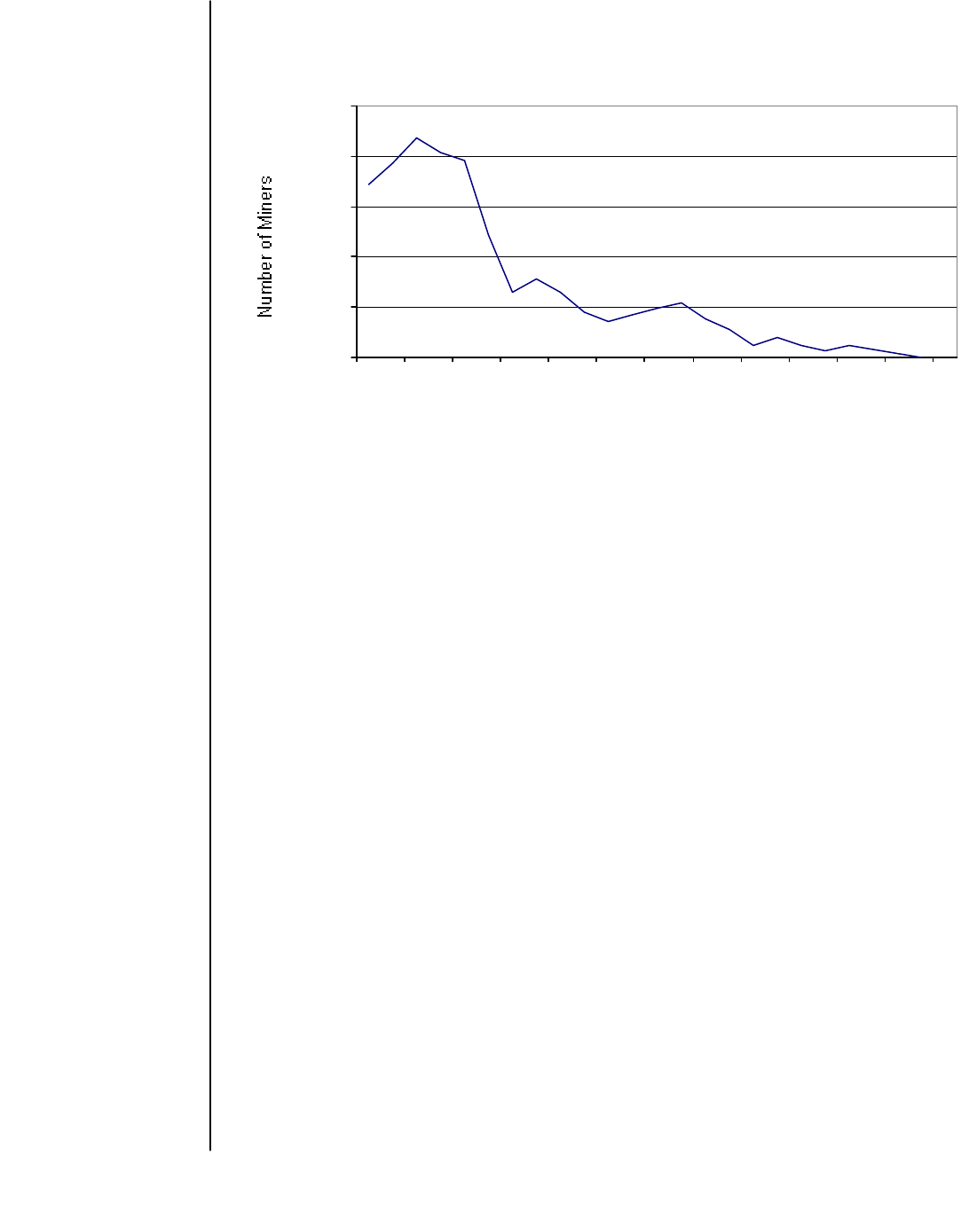
vention does not establish that forced com-
pliance contributed to the decline.
Even assuming that the trend toward
safer mines accelerated after 1969 or after
1977, there would still be questions about
causation because a correlation, by itself,
does not establish cause and effect. For exam-
ple, using the Labor Department’s simplistic
reasoning, it could be argued that MSHA’s
forced compliance model, which was expand-
ed in 1977, has been extraordinarily effective
at eliminating mining jobs in the United
States (Figure 3).
Although the creation of MSHA coincides
with the loss of 30 percent of all U.S. mining
jobs in the last 25 years, that correlation, by
itself, does not prove that the Mine Act elimi-
nated mining jobs. Thus, without the benefit
of a statistical analysis that establishes that the
trend toward safer mines accelerated after pas-
sage of the acts and without a tested theory of
causation, MSHA’s claims are pure puffery.
112
There is one 1980 study that at first glance
appears to support some of MSHA’s self-
aggrandizing conclusions.113 Professors
Michael Lewis-Beck and John Alford conclud-
ed, on the basis of a multiple interrupted time
series (MITS) statistical analysis, that “the
1941 and 1969 federal safety legislation
appears to have diminished significantly the
risk of receiving a fatal injury while mining
coal.”114 To a certain extent, the time series
data, which they developed, statistically quan-
tify the declines in fatalities per number of
coal miners after 1969 that can be observed
using MSHA’s data (Figures 4 and 5).
In addition to attributing statistical sig-
nificance to the downward slope in coal min-
ing fatality rates after 1969, the professors
further concluded that the observable
decline was attributable to “regulatory influ-
ences” and not changes in mine size, technol-
ogy, or the type of mining.
115
While the Lewis-Beck and Alford study is
certainly a step in the right direction in terms
of attempting to determine whether forced
compliance influenced the trend toward fewer
mine fatalities, it is by no means the end of the
story. In this respect, their ultimate conclu-
sion, that “it is possible for Congress to enact
12
Figure 3
The Loss of U.S. Mining Jobs after Enactment of the Mine Act
Sources: Author’s calculation (metal/nonmetal miners + coal miners) based on data from U.S. Department of
Labor, MSHA Internet, Metal/Nonmetal Fatalities 1900 [1931] through 2001, www.msha.gov/centurystats/mnm
stats.htm; and U.S. Department of Labor, MSHA Internet, Coal Fatalities for 1900 through 2001, www.msha.gov/
centurystats/coalstats.htm.
350,000
400,000
450,000
500,000
550,000
600,000
1977 1979 1981 1983 1985 1987 1989 1991 1993 1995 1997 1999 2001
Year
Even assuming
that the trend
toward safer
mines accelerated
after 1969 or after
1977, there would
still be questions
about causation
because a correla-
tion, by itself,
does not establish
cause and effect.

13
Figure 4
U.S. Coal Mining Fatalities per 100,000 Miners
Source: Author’s calculation ([fatalities ÷ number of miners] × 100,000) based on data from U.S. Department of
Labor, MSHA Internet, Coal Fatalities for 1900 through 2001, www.msha.gov/centurystats/coalstats.htm (sand and
gravel workers included beginning in 1958, office workers in 1973).
Figure 5
U.S. Metal/Nonmetal Mining Fatalities per 100,000 Miners
Source: Author’s calculation ([fatalities ÷ number of miners] × 100,000) based on data from U.S. Department of
Labor, MSHA Internet, Metal/Nonmetal Fatalities 1900 [1911] through 2001, www.msha.gov/centurystats/mnm
stats.htm (sand and gravel workers included beginning in 1958, office workers in 1973).
0
100
200
300
400
500
600
1900
1905
1910
1915
1920
1925
1930
1935
1940
1945
1950
1955
1960
1965
1970
1975
1980
1985
1990
1995
2000
Year
0
20
40
60
80
100
120
140
160
180
200
1931
1935
1939
1943
1947
1951
1955
1959
1963
1967
1971
1975
1979
1983
1987
1991
1995
1999
Year

laws that successfully regulate American busi-
ness for some public purpose, such as safer
coal mines,”
116
sounds more political than
analytical or factual. Although their analysis
may be more glamorous than the numbers
that MSHA tosses around on Capitol Hill, it is
no more compelling for at least a half dozen
reasons.
First, as is the case in any time series analy-
sis, the study, by selecting independent vari-
ables, arbitrarily defines the data set. Lewis-
Beck and Alford selected 1941, 1952, and
1969 because federal legislation affecting
mine safety was enacted in those years. The
particular problem with that approach is
that Lewis-Beck and Alford neglected to
include the 1910 creation of the Bureau of
Mines. Their exclusion of the 1910 legisla-
tion is totally inconsistent with their inclu-
sion of the 1941 legislation, which allowed
the federal government to make recommen-
dations to mine operators, because it is iden-
tical in principle to the approach taken by the
federal government in 1910. By erroneously
treating the Mine Inspection Act of 1941 as
“the ‘first’ law” affecting the mining indus-
try,
117
the study ignores the important and
continuing contribution of the Bureau of
Mines that began in 1910, thereby exaggerat-
ing the purported observed effects of the
other laws.
Second, the more general problem with
preselecting variables is that it imposes pre-
conceived ideas on the data instead of allow-
ing the graphic representation of the data to
suggest areas of inquiry. At least with respect
to safety issues, the starting point should be
to identify statistically meaningful trends
and then to work backwards, hypothesizing
about the factors that may have contributed
to the trends. In that regard, eyeballing
Lewis-Beck and Alford’s man-hour data
points suggests that the steep downward
trend, which they attribute to the 1969 act,
actually began 10 years earlier in 1960, which
incidentally coincides with the introduction
of the roof-bolting machine to underground
coal mining.
118
Although the MITS approach
might be useful in supporting a preconceived
idea (to the extent that the data cooperate), it
is not especially appropriate in a field where
proper identification of causes and effects
can be a matter of life and death.
Third, the Lewis-Beck and Alford study
relies on a simplistic data set. While the use of
conglomerated data is certainly convenient
and possibly appropriate to show general
trends, it does not have as much explanatory
power as the unconglomerated data.
119
Inside
the Bureau of Mines’ data set are potential
subsets of data: surface versus underground,
bituminous versus anthracite, western versus
eastern, large mine versus small mine, state
versus state, and even union versus nonunion.
Each subset may tell a different story about
the effects of federal legislation. In addition,
because they looked at only the national
trends, Lewis-Beck and Alford made no
attempt to differentiate between mining disas-
ters and normal-course-of-work fatalities. A
large disaster, such as Farmington where 78
miners died in a single accident, can distort
short-term and long-term trends, such as the
downward trend in coal mine fatalities that
appears to have begun in the early 1960s.
Fourth, Lewis-Beck and Alford greatly exag-
gerate the utility of MITS analysis in making
cause and effect determinations. They conclude
that “beyond doubt, the harsher provisions of
the 1969 Act have made the coal mines safer.”
120
However, of the ”numerous” variables that
might affect mine safety, their study attempts
to account for only three, for which they “man-
aged to assemble satisfactory data.”
121
Lewis-
Beck and Alford considered only mine size,
mining technology, and type of mining. There
are numerous other possible macro explana-
tions that might account for the favorable
trends in coal mining fatalities, including, but
not limited to, the replacement of tort liability
with workers’ compensation, the subsequent
reform of workers’ compensation, the develop-
ment of third-party and product liability doc-
trines, the standard of living, the proliferation
of mass media communications, the mass con-
sumption of automobiles, the build-out of the
medical infrastructure, and even U.S. participa-
tion in foreign wars. They also did not evaluate
14
The steep down-
ward trend in
fatalities coin-
cides with the
introduction of
the roof-bolting
machine to
underground coal
mining.

numerous potential mining-specific explana-
tions for the favorable trends in fatalities,
including, but not limited to, the price of coal,
national demand for coal, the nature of the
mining labor force,
122
the consolidation of
mine operators, state mining laws, and geo-
graphic mining activity. As the study concedes,
those other unaccounted-for variables might
“contribute significantly to an explanation of
mine safety.”
123
Fifth, with regard to the variables that
Lewis-Beck and Alford attempted to take into
account (mine size, mining technology, and
type of mining), it is not altogether clear that
simply treating them as “third variables” ade-
quately captures the extent of their effect on
mine safety.
124
Moreover, the indicators that
they selected to represent those variables are
also questionable. For example, using produc-
tivity as the sole indicator of advances in min-
ing technology would not capture technologi-
cal innovations that substantially enhance
safety without significantly affecting produc-
tion, such as the proliferation of permissible
explosives, permissible equipment, rock-dust-
ing applicators, self-rescuers, rollover protec-
tion, fire alarm and suppression systems, ven-
tilation techniques, and roof bolting. In addi-
tion, to the extent that the federal legislation
may be responsible for declines in productivi-
ty, the full effect of non-safety-specific innova-
tions might actually be hidden by their “third
variable” approach.
There Is No Evidence That
the Mine Act Has Effectively
Reduced Fatalities
The sixth and most important reason that
the Lewis-Beck and Alford study does not
withstand scrutiny is that it relies on an infe-
rior measure of mine safety progress. A com-
parison of (1) annual fatalities per 100,000
miners, which is MSHA’s version of Lewis-
Beck and Alford’s annual fatalities per mil-
lion man-hours,
125
and (2) annual fatalities
per million tons mined shows discrepant
trends.
One interpretation of the discrepancy,
which appears in Figure 6, is that fatality rates
per miner and, by extension, rates per man-
hour,
126
do not accurately represent the favor-
able trend in mine safety improvement.
The fatalities per million tons rate, which
shows a near continuous downward trend, is a
superior measure of mine safety. Fatality rates
based on tonnage are superior to fatality rates
based on miners or man-hours because they
reflect changing exposure to mine hazards
more accurately. Although a man-hour rate
reflects exposure somewhat better than does
the number of employees, a man-hour rate
does not adequately capture a miner’s expo-
sure to hazards because it assumes that the
pace of mining per hour is constant over time.
The reality is that miners move more ground
in one hour today than they did in 1900.
127
It
is generally accepted that the more ground is
moved, the more hazards will be encoun-
tered.
128
For that reason, the fatalities per mil-
lion tons rate, which better captures the haz-
ards encountered during mining, is a better
means of assessing safety progress within the
coal mining industry.
129
Fatalities per million tons is a superior
measure of intraindustry safety progress from
a public policy perspective as well.
130
It direct-
ly correlates coal output, which public policy
aims to maximize, and fatalities, which public
policy aims to minimize. By directly compar-
ing the two most relevant variables, the possi-
bility of a false safety gain is eliminated. When
using fatalities per million man-hours,
changes in productivity can conceal changes
in safety. A decline in productivity, resulting
from more miners mining less coal, can make
the mines appear safer even when fatalities in
the more dangerous mining occupations do
not decline in absolute numbers. For example,
adding miners to do nonproduction work,
such as liaising with MSHA inspectors or fill-
ing out paperwork, away from the face of an
underground coal mine can lower fatality
rates per man-hour or per miner without low-
ering the fatality rate per ton.
131
In this connection, Labor Department
employee Hal Sider, in an unheralded but
15
A comparison of
annual fatalities
per 100,000 min-
ers and annual
fatalities per mil-
lion tons mined
shows discrepant
trends.
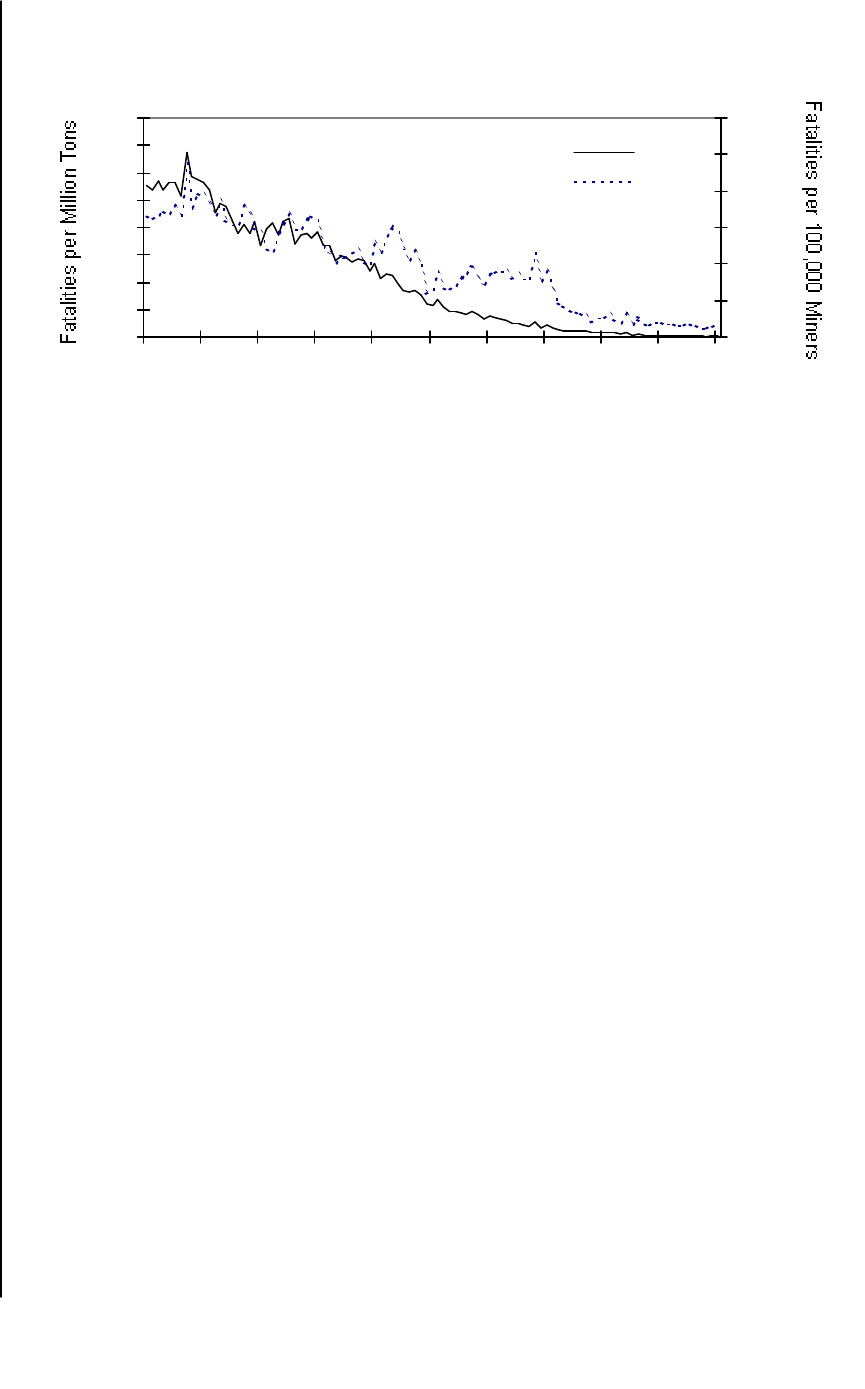
important statistical analysis,
132
found that the
“spectacular decline in productivity during the
1970s” was not the result of improvements in
safety conditions but rather the result of a sim-
ple decline in the production of marketable
output.
133
The converse and corollary implica-
tion of Sider’s analysis is that the productivity
declines that followed the 1969 Coal Act
134
may
also explain the improvement in the fatality per
man-hour rate observed by Lewis-Beck and
Alford.
135
In other words, the improvement in
fatalities per million man-hour data that fol-
lowed the 1969 Coal Act might actually reflect
a decrease in exposure to hazards resulting
from each employee mining less coal and not
from a genuine improvement in mine safety.
The clear implication of Sider’s analysis is that
the beneficial safety effects of the Coal Act
observed by Lewis-Beck and Alford are illusory.
In sum, while the man-hour and employee
rates may be useful for comparing mining
with other industries and for informing min-
ers about the relative risks that they face com-
pared with workers in other industries, the per
ton rate is superior as an intraindustry mea-
sure of safety progress. For example, the per
million ton measure is used to compare the
safety of mines in different countries whose
productivity rates may vary considerably.
136
Although MSHA does not use the measure on
a regular basis, the agency has used it when it
helps make a point.
137
Figure 7 isolates and
enlarges the fatalities per million tons trend
set out above in Figure 6.
The implications of Figure 7 are profound.
It appears that the federal government inter-
vened at a point when safety gains on a per mil-
lion ton basis were already declining at a rapid
rate. Moreover, unfavorable changes in the
trend that coincide with federal intervention
raise serious questions about whether forced
compliance may actually have even been detri-
16
The improvement
in fatalities per
million man-hour
data that followed
the 1969 Coal Act
might actually
reflect a decrease
in exposure to
hazards resulting
from each
employee mining
less coal and not
from a genuine
improvement in
mine safety.
Figure 6
Divergent U.S. Coal Mining Fatality Rates
0
1
2
3
4
5
6
7
8
1900
1910
1920
1930
1940
1950
1960
1970
1980
1990
2000
0
100
200
300
400
500
600
Per Ton
Per Miner
Sources: Fatalities per ton, author’s calculation (fatalities ÷ tons ×
1000) based on data from U.S. Department of
Labor, MSHA Internet, Coal Fatalities for 1900 through 2001 www.msha.gov/centurystats/coalstats.htm; Energy
Information Administration, Coal Products Publications, Coal Data: A Reference, Table 18, U.S. Production Trends
in Bituminous Coal and Lignite, 1900–1993 (total production, thousand short tons), 1995, pp. 65–66,
http://tonto.eia.doe.gov/FTPROOT/coal/006493.pdf; Pennsylvania Department of Environmental Protection,
Mining and Reclamation, 2000 Annual Report on Mining Activities, Table 1: Anthracite Statistical Summaries
1870 to 2000 (production, net tons, converted to thousand tons), www.dep.state.pa.us/dep/deputate/minres/bmr/
annualreport/2000/table_01.htm; and Energy Information Administration, Coal Products Publications, Coal
Industry Annuals 1994–2000 (thousand short tons), http://tonto.eia.doe.gov/FTPROOT/coal/coalpubs.htm.
Fatalities per miner, author’s calculation ([fatalities ÷ number of miners] ×
100,000) based on data from U.S.
Department of Labor, MSHA Internet, Coal Fatalities for 1900 through 2001, www.msha.gov/centurystats/coal
stats.htm
Year
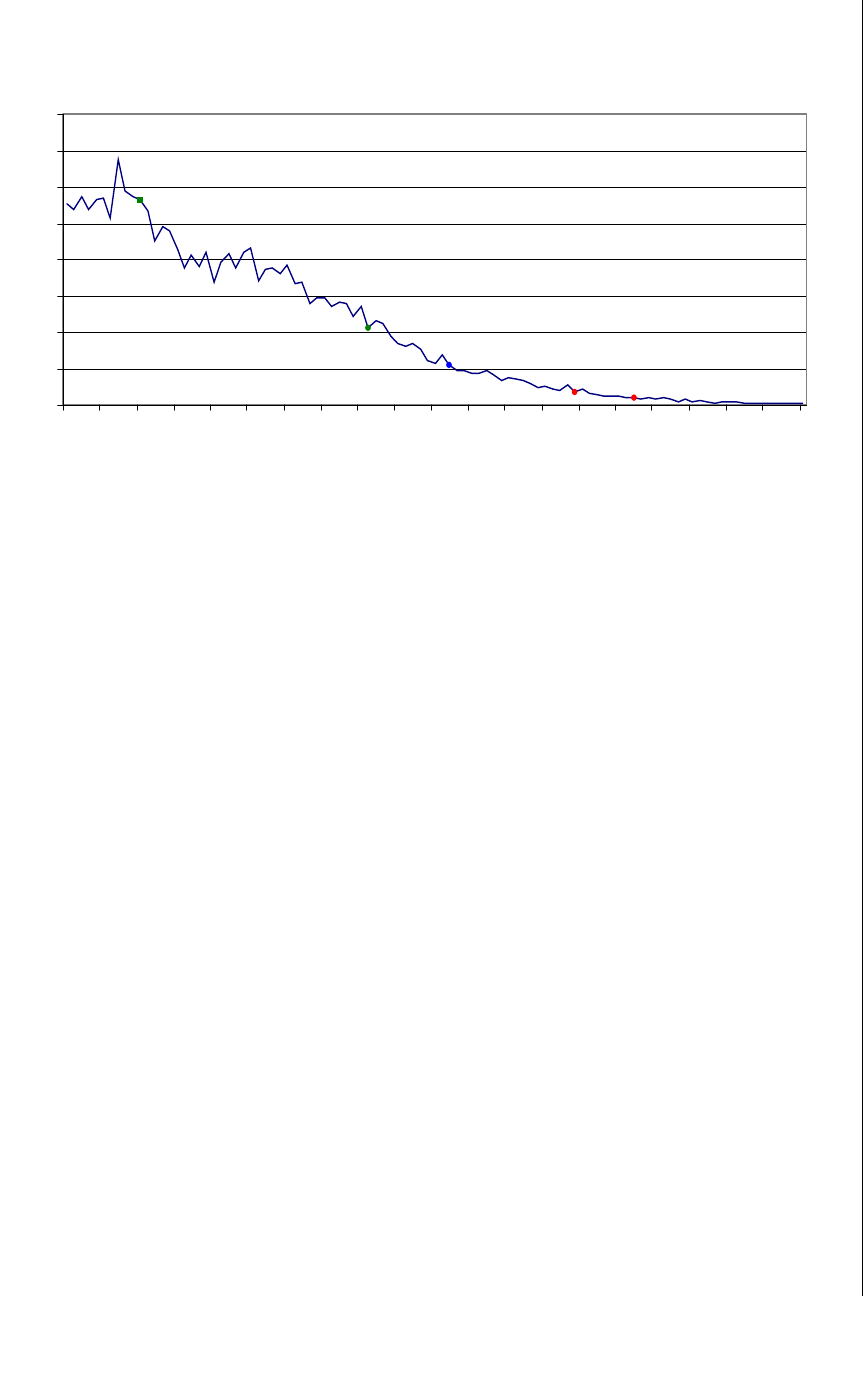
mental to mine safety.
138
An MITS analysis of
the data, akin to Lewis-Beck and Alford’s study,
would almost certainly show that each succes-
sive stage of increasing federal intervention,
especially after 1941, progressively slowed the
trend toward safer coal mines. Thus, it is entire-
ly possible that the federal government not only
got to the safety-improvement celebration late
but may also have broken up the party.
The Reasons Forced
Compliance Does Not
Protect Miners
Alleging that federal intervention has been
detrimental to mine safety is considered
heresy even by critics of the forced compliance
model, who at least pay homage to the historic
role that forced compliance has played in
bringing mine safety to where it is today.
139
In
addition, attempting to establish that the
Mine Act has stalled the trend toward fewer
mine fatalities presents the same statistical
and causation hurdles that proponents of the
enforcement model have conveniently ignored
in touting the lifesaving benefits of the Mine
Act. Nonetheless, a comparison of the forced
compliance and market models suggests that
it is entirely possible that Congress may have
actually done more harm than good with the
Coal and Mine Acts. Each of the three compo-
nent parts of the forced compliance approach
is inferior to the equivalent feature of the mar-
ket-based approach that it tried to replace and,
more important, may impair the effectiveness
of the market-based counterparts.
The Substitution of Rules for Results
In the market-based approach to mine
safety there are no restrictions on the means
by which mine operators achieve reductions in
17
It is entirely pos-
sible that the fed-
eral government
not only got to
the safety-
improvement
celebration late
but may also have
broken up the
party.
0
1
2
3
4
5
6
7
8
1900
1905
1910
1915
1920
1925
1930
1935
1940
1945
1950
1955
1960
1965
1970
1975
1980
1985
1990
1995
2000
Figure 7
Behind the Curve: Increased Intervention by the U.S. Government in Mine Safety
May Have Decreased the Rate of Decline in Coal Fatality Rates
Sources: Author’s calculation (fatalities ÷ tons × 1000) based on data from U.S. Department of Labor, MSHA
Internet, Coal Fatalities for 1900 through 2001, www.msha.gov/centurystats/coalstats.htm; Energy Information
Administration, Coal Products Publications, Coal Data: A Reference, Table 18, U.S. Production Trends in
Bituminous Coal and Lignite, 1900–1993 (total production, thousand short tons), 1995, pp. 65–66, http://tonto.
eia.doe.gov/FTPROOT/coal/006493.pdf; Pennsylvania Department of Environmental Protection, Mining and
Reclamation, 2000 Annual Report on Mining Activities, Table 1: Anthracite Statistical Summaries 1870 to 2000
(production, net tons, converted to thousand tons), www.dep.state.pa.us/dep/deputate/minres/bmr/annual
report/2000/table_01.htm; and Energy Information Administration, Coal Products Publications, Coal Industry
Annuals 1994–2000 (thousand short tons), http://tonto.eia.doe.gov/FTPROOT/coal/coalpubs.htm.
Fatalities per Million Tons of Coal
Year
1910: BOM Disseminates Information
1941: BOM Makes Recommendations
1952: BOM Issues Second Instance Violations
1969: BOM/MESA Issues First Instance Violations
1977: MSHA Issues First Instance Violations with Stiffer Penalties

injuries. Mine operators are free to use
employee bonuses, engineering controls,
behavior-based programs, or whatever else
works to bring down injury rates. In contrast,
the forced compliance model depends entirely
on the administration and enforcement of
regulations to reduce accidents. There are
numerous shortcomings inherent in the regu-
latory approach.
First, it has never been established that
regulation of mining operations prevents
accidents. Conventional wisdom holds:
The risks regulated by these two agen-
cies are well understood. We know we
need regulations on ladders, slippery
floors, lighting, and similar matters in
order to protect workers. We know from
experience that these agencies’ regula-
tions prevent deaths. We do not want to
meddle with success.
140
However, even scholarly proponents of forced
compliance have conceded the possibility that
safety regulations might not have any positive
impact on accident rates.
141
As set out above, a
preliminary look at the fatalities per million
tons data suggests that forced compliance
might have actually slowed the trend toward
fewer fatal injuries at coal mines.
142
Regardless of whether any accidents can be
prevented with regulations, it is clear that all
accidents cannot be eliminated through regula-
tion. One occupational safety and health schol-
ar has noted that even in less dynamic OSHA-
regulated environments, “most workplace
injuries are not caused by violations of stan-
dards, and even fewer are caused by violations
that inspectors can detect.”
143
There have been
fatalities at mining operations where even
MSHA, which strives to cite a violation in every
fatality case,
144
has conceded that there was no
violation of the regulations.
145
It is simply
impossible to address all conceivable hazardous
conditions and practices through regulation.
In response to the fact that it is impossible
to regulate every conceivable hazard at min-
ing operations, many of MSHA’s regulations
are deliberately vague with respect to the spe-
cific conditions or practices that are required
or prohibited. For example, many of the
metal/nonmetal regulations simply instruct
mine operators to be “safe” and to avoid
practices or conditions that may create a
“hazard” or be “dangerous.”
146
Although it
has been held by the courts that such “per-
formance” regulations meet the minimum
requirements of due process
147
and although
such “performance” regulations do afford
the mine operator flexibility in achieving
compliance,
148
the reality is that such regula-
tions provide no meaningful guidance to
mine operators about what conditions may
be hazardous or how to eliminate them.
While such regulations are ideal for 20/20
hindsight enforcement, they are worthless as
guidelines for the prevention of accidents.
149
The regulations that are specific enough to
provide guidance to mine operators are often
too prescriptive. Many MSHA regulations,
particularly ones governing coal mining, are
so specific that they discourage innovation.
150
Mine operators are generally reluctant to
implement high- or even low-tech safety inno-
vations because doing so, in many instances,
requires the mine operator to petition MSHA
for a variance.
151
Under MSHA’s regulations,
such variances, even if granted on the first go
around, take a minimum of 60 days.
152
It often
takes many months or sometimes even years
to get a variance.
153
In some instances, where
the mine operator cannot convincingly per-
suade an Arlington, Virginia, bureaucrat that
its innovative approach will not diminish safe-
ty in any way, variances are not granted at
all.
154
The limitations of such a system in an
industry in which conditions change hourly
are obvious. Indeed, all but the most ardent
advocates of regulation have conceded that
regulations do not induce innovation.
155
Perhaps the biggest failing of MSHA’s regu-
lations is their relentless focus on the “unsafe
condition and unsafe act” approach to mine
safety to the detriment of other more innova-
tive approaches. Almost all of MSHA’s regula-
tions address workplace conditions. While
there are a few regulations that prohibit unsafe
actions, they have not been particularly effective
18
It has never been
established that
regulation of
mining opera-
tions prevents
accidents.

at changing behavior.
156
In this connection,
modern accident prevention theory, which
focuses on behavior-based approaches to
improving safety, has passed by MSHA’s regu-
latory approach, which remains firmly rooted
in the “unsafe-act/unsafe-condition” theory
developed in the first third of the 20th centu-
ry.
157
Although MSHA regulations do not pre-
clude mine operators from implementing
behavior-based safety programs, the perception
in the industry is that MSHA, whose focus is on
assigning blame to the mine operator and pro-
tecting employee rights, is not receptive to
behavior-based approaches.
158
Moreover, small-
er mining operations, which often do not have
the resources to implement two types of safety
programs, are forced to focus their available
resources on a safety program that is geared
toward regulatory compliance.
159
The Substitution of Inspector Vigilance
for Employee Vigilance
The keystone of the market-based approach
to mine safety is the strong incentive that an
individual miner has to provide for his own
safety and well-being. In contrast, the regulato-
ry approach to safety embodied in the Mine
Act, which essentially creates a miner’s entitle-
ment to a safe workplace, largely exempts min-
ers from responsibility for their own and others’
safety. Instead, the Mine Act approach relies pri-
marily on periodic, mandatory inspections con-
ducted by federal mine inspectors to enforce
compliance with the regulations. The forced
compliance approach is inferior to the market
approach, not only because inspectors are inca-
pable of doing a better job than miners at
ensuring a safe workplace, but also because
forced compliance creates a moral hazard for
the miners.
Although the 1977 Congress recognized
that the individual miner had an essential role
even in the forced compliance approach to
mine safety,
160
the Mine Act placed the entire
responsibility for safety on the mine operator.
The 1977 Congress explained:
Thus, while miners are required to com-
ply with standards insofar as they are
applicable to their own actions and con-
duct, except with respect to the penalty
for smoking in a mine, (Section 111(i)),
neither the bill, nor current law contem-
plates that citations and penalties be
issued against miners. Operators have
the final responsibilities for affording
safe and healthful workplaces for miners,
and therefore, have the responsibility for
developing and enforcing through
appropriate disciplinary measures, effec-
tive safety programs that could prevent
employees from engaging in unsafe and
unhealthful activity.
161
Thus, even though the Mine Act pays lip service
to the important role of miners,
162
the act
exempts the individual miner from any civil or
criminal liability, with the one exception related
to smoking, regardless of whether he puts him-
self, others, or the mine operator’s equipment
at risk. With respect to smoking, the average
civil penalty issued to miners when they are
caught by MSHA is only $181.
163
As a proxy for the vigilance of miners,
164
the
Mine Act relies on regular federal inspections to
ensure that mine operators are in compliance
with the federal safety regulations. Under the
Mine Act, MSHA is required to inspect surface
operations twice a year and underground oper-
ations four times a year.
165
Former MSHA
administrator McAteer has emphasized the
importance of federal inspections under the
Mine Act:
I wish I could say that it is now safe to
relax our vigilance on miners’ safety and
health, but that simply is not the case.
Even with strong enforcement, criminal
violations of federal mine safety stan-
dards have led to mine disasters such as
the Southmountain mine explosion that
killed eight Virginia coal miners less than
three years ago. Less vigilance through
inspections invites a greater danger of
mining accidents.
166
In the endless pursuit of ever-greater vigi-
lance, it is not uncommon for federal mine
19
The regulatory
approach to safe-
ty embodied in
the Mine Act,
which essentially
creates a miner’s
entitlement to a
safe workplace,
largely exempts
miners from
responsibility for
their own and
others’ safety.

inspectors to spend weeks or even months at
particular mining operations.
167
The fundamental problem with inspector
vigilance is that there can never be enough of
it. As McAteer explained:
Mines are complex. By definition, the
working environment changes all the
time. As mined material is removed, an
entirely new workplace is created in as
little as 24 hours. Roof conditions vary
from place to place. Explosive methane
may be liberated. Mechanical systems
may fail. A mine that is safe one day
may be dangerous the next. A mine
with a good safety record may confront
new challenges daily. Personnel
changes, too, can make a dramatic dif-
ference in the safety of a mine.
168
Extending McAteer’s reasoning to its logical
conclusion, every work crew at every mine on
every shift would have to include one full-
time federal mine inspector in order for the
inspections to have a realistic chance of effec-
tively ensuring compliance with federal regu-
lations at all times.
In addition to not having a realistic oppor-
tunity to be vigilant,
169
federal inspectors do not
have the same incentives as employees to ensure
that the workplace is safe.
170
An employee who
fails to discover a hazard may lose his life or
limb or the life or limb of a friend, whereas an
inspector who fails to discover a hazard may
not even get a reprimand.
171
Moreover, while
most MSHA inspectors have good intentions,
there are some who have been corrupted by
bureaucratic apathy, political pressure, career
advancement goals, a desire for job security,
abuse of power, or personal animosity.
172
Compounding the problem of incentives is
the problem of competence. Frequently, MSHA
inspectors are not qualified to perform the
inspections to which they are assigned.
173
Even
where the MSHA inspector may have general
information about safe work practices and con-
ditions as contained in the regulations, he usu-
ally lacks specific information about the mine
and its miners. Essentially, an MSHA inspector
makes his compliance determinations in an
information vacuum. For example, the MSHA
inspector may not know (or may not care to
know) that safety resources have not been com-
mitted to a particular area of the mine because
it does not present any safety risks.
174
Perhaps the greatest problem with federal
inspections is not that they can never augment
employee vigilance but rather that, to some
extent, they have become a substitute for
employee vigilance. As is often the case with
entitlement schemes, the Mine Act has created
a moral hazard, whereby miners have reduced
incentives to provide for their own safety as well
as the safety of others. Although it is difficult to
measure the impact of the moral hazard on the
behavior of miners, there are plenty of anecdo-
tal accounts of employees who have not taken
responsibility for their own personal safety.
175
For example, miners have stated:
[Without MSHA] no one will be there
to make sure I bother putting on a
hard hat or my hardsole boots, and,
who needs to carry that old self rescuer
anyway?
176
And
I have worked where the continuous
miner operator cut coal without venti-
lation curtains and in high concentra-
tions of methane and even cutting
cross sections together in unsupported
roof and cutting deep cuts out from
unsupported roof. All of this in viola-
tion of the approved mining plan.
177
Moreover, the fact that numerous lawsuits
have been brought against MSHA alleging
negligent inspection indicates that there is at
least a general perception in mining commu-
nities that MSHA serves as the ultimate guar-
antor of the safety of miners working in the
nation’s mines.
178
In this connection, the irony of McAteer’s
testimony to Congress regarding South-moun-
tain is that the disaster was attributable not to a
failure of federal vigilance but rather to lack of
20
The fundamental
problem with
inspector vigi-
lance is that there
can never be
enough of it.

miner vigilance. In all likelihood, the
Southmountain explosion was ignited by one
or more individual miners who decided to
smoke cigarettes in a mine that was known to
contain high concentrations of methane.
179
The Substitution of Sanctions for
Cooperation
An essential element of the market-based
approach to mine safety is adequate informa-
tion. Miners need information in order to
demand adequate risk premiums, and mine
operators need information in order to be inno-
vative accident preventers. In contrast, the
forced compliance approach relies on sanctions
to coerce compliance with regulations. While
the threat of sanctions that comes with the
Mine Act has probably been insignificant in
reducing accidents, it has been instrumental in
cutting off the information exchange between
mine operators and government.
Although the 1977 Congress attempted to
supplant the market for safety with police inter-
vention, it was not successful. The fallacy of
that approach lies in the numbers. Under the
Mine Act, the maximum civil penalty is $55,000
per violation. However, the act requires that
MSHA consider negligence, gravity, abatement
efforts, history of violations, size of the mine
operator, and ability to pay in assessing civil
penalties.
180
As a result, the average regular civil
penalty assessment in fiscal year 2000 was
$255.
181
A substantial number of assessments
were issued at the mandatory minimum civil
penalty of $55.
182
Regardless of whether or not such nominal
penalties create incentives for regulatory com-
pliance,
183
they are insignificant when com-
pared with the other monetary incentives that
are in place to encourage operators to invest in
accident prevention. In 2000 MSHA collected
just over $17 million in civil penalties from the
mining industry.
184
In contrast, the mining
industry probably paid hundreds of millions,
perhaps even billions, in risk premiums, in
injury costs, and for workers’ compensation
and insurance premiums.
185
Although plenty
of sanction-motivated, compliance-related
activity certainly occurs in the mining indus-
try,
186
the threat of sanctions is not by any mea-
sure the primary incentive that drives mine
operators to prevent accidents.
187
Of course, not all penalties assessed by
MSHA are $255 or less. In cases involving
injuries to employees, MSHA often issues sub-
stantial penalty assessments.
188
The average
civil penalty assessment in accident-related
cases was $31,000 in FY 2000.
189
To the extent
that such penalties add to the cost of injuries,
they may augment the preexisting market-
based monetary incentives for mine operators
to prevent future injuries. In this connection,
injury-related assessments function much like
an injury tax.
190
However, unlike an injury tax,
which is applied across the board, an injury-
related civil penalty assessment is unpre-
dictable.
191
It depends on whether MSHA’s acci-
dent investigation team can identify a legally
valid causal link to a regulation.
192
It also
depends on the secretive workings of the assess-
ment office
193
as well as the views of the Federal
Mine Safety and Health Review Commission
and the courts.
194
Because the penalty assess-
ment cost cannot be estimated in advance and
factored into decisions about investments in
accident prevention programs, its effectiveness
as an incentive is probably minimal.
Although the Mine Act’s civil penalty
scheme probably does not create significant
incentives for accident prevention, it does
create a substantial disincentive to coopera-
tion with the federal government. MSHA has
made it all too clear that it is not a public ser-
vice agency as was the Bureau of Mines. As
former administrator McAteer explained:
We have two responsibilities that are
sometimes at odds. First just like the
state police, we must enforce the law
and we mean to do that. Second, when
we identify a problem we will use what-
ever means available, such as public ser-
vice announcements, to get the message
out. But we are not a public service or
advisory agency. We have to carry out
our enforcement responsibility.
195
21
While the threat
of sanctions has
probably been
insignificant in
reducing acci-
dents, it has been
instrumental in
cutting off the
information
exchange between
mine operators
and government.

In a demonstration of the agency’s commit-
ment to enforcement at the expense of assis-
tance through information, McAteer elimi-
nated MSHA’s technical support group in the
western United States, where mining is on the
rise, and transferred its remaining functions
to his home state of West Virginia, where min-
ing is on the decline.
196
Although the credibil-
ity and utility of the technical support branch
under the direction of an enforcement agency
has always been suspect,
197
the move was
nonetheless symbolic of MSHA’s steadfast
commitment to the enforcement approach.
McAteer emphasized enforcement during
his tenure, but he candidly conceded that the
Mine Act’s enforcement approach was not “the
way to win friends and influence people.”
198
Because the Mine Act imposes civil and crimi-
nal penalties for noncompliance, mine opera-
tors and their agents treat MSHA inspectors as
policemen and MSHA technical support per-
sonnel as potentially hostile expert witnesses
instead of safety professionals.
199
As a result,
MSHA’s relationship with the mining industry
has almost always been adversarial and con-
frontational.
200
Hence, mine operators fre-
quently joke that the two biggest lies in the
mining industry are told by the MSHA inspec-
tor who says “I am here to help” and the mine
operator who replies “we’re glad you’re here.”
Although the impact of the government’s
adversarial relationship with the mining
industry on mine safety has not been studied,
it is likely that the dearth of meaningful
information exchange has been damaging in
comparison with the apparent success of the
cooperative approach demonstrated by the
Bureau of Mines in the early part of the 20th
century.
201
In all but exceptional cases, coop-
eration and information sharing are superior
to punishment and adversarial relations.
202
The Possibility of
Diminishing Returns
Although it is fair to say that MSHA will
never concede that the Mine Act and its prede-
cessors may have slowed the trend toward fewer
mine fatalities, MSHA has at least recognized
that the trend has slowed. McAteer noted:
We [have] taken fatalities and accidents
from a very high number down to a lower
number, but now we need to take it to the
next level. And why can’t we do that? . . .
Why can’t we find the solution?
203
Assistant Secretary of Labor Dave Lauriski, now
head of MSHA, similarly commented that
there had been “a flattening of those numbers—
over the past five years in particular.”
204
It is possible that the reason the mining
industry cannot bring mine fatalities to the
“next level” is that the Mine Act is interfering
with safety progress. Forced compliance may
well be part of the problem, not part of the
solution.
It is alternatively possible that the trend
toward fewer fatalities has reached the point
of diminishing returns. In absolute numbers,
mine fatalities dropped from 1,688 in 1931
to 72 in 2001, a 96 percent reduction.
205
It
may be that the mining industry has already
eliminated the easy-to-prevent fatalities and
that the final 4 percent present a more diffi-
cult challenge. Perhaps, with current mining
technologies and methods, a certain number
of fatalities cannot be eliminated at all.
206
Regardless of the explanation for the flat-
tening, the fact of the matter is that there is
no evidence that forced compliance has been
more effective than nonintervention. On a
fatalities per million ton basis, coal mine
fatalities appear to have declined faster
before forced compliance than they did after.
Because in all likelihood the Mine Act has
not met its stated statutory objective, its
forced compliance provisions should be
reviewed and possibly repealed.
The Cost/Benefit of Forced
Compliance
Even assuming that all mining deaths are
ultimately preventable and further assum-
ing, purely for the sake of argument, that
22
There is no evi-
dence that forced
compliance has
been more
effective than
nonintervention.

forced compliance contributes to prevention,
the forced compliance provisions of the Mine
Act still should be repealed. If one assumes
that the Mine Act saves a substantial number
of lives each year (which, given the foregoing,
is a rather dubious assumption), the estimat-
ed costs of forced compliance still exceed its
benefits by more than a factor of four. From
a cost/benefit perspective, the Mine Act is
simply not a wise use of the resources that
society chooses to commit to lifesaving.
The Costs of Forced Compliance
The most obvious cost associated with
forced compliance is the annual cost of admin-
istering the Mine Act. In FY02 Congress appro-
priated $246 million to MSHA.
207
To a certain
extent, the forced compliance budget should be
offset by civil penalty collections by MSHA,
which totaled about $17 million in FY 2000. In
addition, $27 million was appropriated for the
technical support branch, which is involved in
some nonenforcement activity.
208
However, the
budgeted amount does not include amounts
appropriated to the Department of Labor for
attorneys in the Solicitor’s Office who litigate
Mine Act cases or investigators in the Inspector
General’s Office who investigate inspector cor-
ruption. The budgeted amount also does not
include approximately $4 million appropriated
to the Federal Mine Safety and Health Review
Commission, which adjudicates disputes
between mine operators and MSHA.
209
To put
the costs of administering the Mine Act in per-
spective, the federal government spends
approximately $12,300 per inspection
210
and
$1,863 per assessed violation,
211
or $702 per
miner.
212
The $246 million that the federal govern-
ment spends on forced compliance pales in
comparison with the amount spent by the
mining industry to comply with MHSA’s reg-
ulations.
213
For example, operators have to
commit resources to installing guards, buy-
ing ladders, building berms, installing roof
bolts, and keeping fans running. Because
mine operators have significant incentives,
other than the threat of sanction, to prevent
accidents, there is no doubt that significant
resources would be committed irrespective of
compliance obligations. However, as the
National Mining Association has empha-
sized:
Many of the current requirements of
the Mine Act contain extraordinary
obligations on the mining industry
without contributing to a reduction in
occupational injuries and illnesses. The
regulations divert finite resources from
effective accident prevention and have
diminished the well-founded principles
of the Mine Act.
214
In addition to diverting resources from other
safety-related activities, compliance with reg-
ulations that do not contribute to a reduc-
tion in injuries also diverts finite resources
from production.
The inspection phase of MSHA’s forced
compliance program also has costs. Every
time a MSHA inspector enters a mine, he ties
up company personnel who have other safety
and production responsibilities. For exam-
ple, MSHA’s walkaround inspections pull
supervisors away from their work areas and
safety personnel away from training and
workplace examination duties.
215
More important, as a result of an inspec-
tion, mine operators are often required to
direct immediate resources to items and
tasks that they do not perceive as genuine or
high-priority safety hazards or even as com-
pliance obligations. For example, in one
reported case, an MSHA inspector required a
mine operator to replace a General Electric
toaster oven and a Proctor Silex toaster that
were located in the mine office because he
believed that the toasters, which were in their
store-bought, U.L.-certified condition, were
not properly grounded in accordance with
federal regulations.
216
In addition to inspection-related costs,
there are substantial costs associated with
the imposition of sanctions. For a variety of
reasons, disputes frequently arise between
MSHA and mine operators about the appro-
priateness of enforcement. For example, the
23
If one assumes
that the Mine Act
saves a substan-
tial number of
lives each year,
the estimated
costs of forced
compliance still
exceed its bene-
fits by more than
a factor of four.

Federal Mine Safety and Health Review
Commission received 2,335 cases in FY99.
217
One mine operator stated that its legal costs
approached $1 million in one such proceed-
ing.
218
Those costs incurred by mine opera-
tors are in addition to the substantial litiga-
tion costs incurred by MSHA, to which the
agency gives little or no regard.
219
It is obvi-
ous that the human and financial resources
committed to those disputes, which appear
to be a necessary evil of forced compliance,
are resources that will never be committed to
safety or to increased production.
220
Remarkably, there are no detailed esti-
mates of the total costs associated with the
forced compliance approach to mine safety
that is required by the Mine Act. Only since
1993 has MSHA attempted to quantify the
estimated costs of forced compliance with
particular regulations.
221
The only available
cumulative estimate of the cost of MSHA’s
forced compliance approach is a $7.4 billion
per year figure put forth by Professor Joseph
M. Johnson of George Mason University’s
Mercatus Center.
222
To arrive at the $7.4 bil-
lion figure, Johnson updated an earlier analy-
sis by E. F. Denison, which measured the
postregulatory productivity changes that
resulted from mine safety and health regula-
tion. Although Johnson found that “the cur-
rent total costs are likely greater than $7.4 bil-
lion,” he determined that “Denison’s esti-
mate is the best available.”
223
The Benefits of Forced Compliance
The initial problem with estimating the ben-
efits of forced compliance is that there may not
be any. It has never been established that forced
compliance has saved one life or prevented one
injury. Although there may be some anecdotal
accounts from the last 25 years of instances in
which MSHA’s actions have been beneficial, the
unfavorable change in the fatalities per million
tons trend that coincides with federal interven-
tion suggests that, at least with respect to coal
mine fatalities, the overall impact of forced
compliance may have been detrimental.
Another problem with estimating the
benefits of forced compliance, assuming that
there are some, is that the lives-saved
approach emphasized by MSHA may not be
a good measure of the overall safety of the
workplace. First, fatal injuries are to a large
extent an aberration and only a small per-
centage of the total number of mining
injuries. For example, in 2000 there were
11,193 nonfatal mining injuries that resulted
in lost workdays.
224
Second, fatal injuries can
decline irrespective of improved accident pre-
vention as advances in medical response and
medical care make it less likely that a partic-
ular injury will result in death.
Even if MSHA’s lives-saved approach is a
fair proxy for the overall safety benefit that
the Mine Act purportedly bestows on the
nation’s mines, it is, nonetheless, very diffi-
cult to place a monetary value on a human
life.
225
MSHA, which often uses the sanctity
of human life as a shield from accountability,
publishes no estimates of the monetary value
of a human life.
226
While it is certainly true
that human life is sacred, it does not follow
that it is unreasonable to assign a monetary
value to it for purposes of allocating scarce
public resources. Estimates of the value of a
human life range from as low as $100,000 to
as much as $6.8 million.
227
Using $6.8 million as an undiscounted
fair valuation of a human life, it is possible to
produce a ballpark estimate of the best-case
monetary benefit that the Mine Act’s forced
compliance program bestows upon society.
Assuming, purely for the sake of argument,
that as a result of forced compliance “coal
miners are five times less likely to be killed on
the job than they were in 1969, and metal
miners twice less likely to die [than in 1977],”
as former labor secretary Reich contends,
MSHA saved approximately 237 lives in
2000. If MSHA is generously credited with
saving all 237 lives and the value of each life
is $6.8 million, then the best-case monetary
benefit of the Mine Act in 2000 was
$1,611,600,000 or about $1.6 billion.
The Net Loss to American Society
On the basis of the very generous benefit
assumptions and conservative cost estimates
24
The problem with
estimating the
benefits of forced
compliance is that
there may not be
any. It has never
been established
that forced com-
pliance has saved
one life or pre-
vented one injury.

described above, it appears that the annual
costs of forced compliance exceed its annual
benefits by more than a factor of four. Of
course, these estimates are crude. Notably,
the cost estimate (presumably) includes the
cost of health regulations, whereas the bene-
fit estimate includes only lives saved through
accident prevention. Nonetheless, the esti-
mates help conceptualize the potential size
of the net loss to society over the 25 years that
the Mine Act has been enforced. The cumu-
lative loss to society could be on the order of
$145 billion.
Some proponents of safety regulation
argue that such cost/benefit analyses are
inappropriate. For example, law professors
Thomas McGarity and Sidney Shapiro, who
are vigorous advocates of the forced compli-
ance approach, maintain:
Public policy making provides us with
an opportunity to express our empathy
with those who are less fortunate. It is
an opportunity for those of us with
sufficient wealth to purchase our way
out of the danger of occupational dis-
ease to choose to protect those who do
not have that option. When we reject
cost-benefit analysis as a guide to pub-
lic policy, we not only better protect
workers, we ennoble ourselves.
228
The problem with the so-called noble or
compassionate approach to social policy,
which dominates present thinking about the
Mine Act,
229
is that society’s resources are not
infinite.
While even McGarity and Shapiro
“acknowledge that trade-offs must inevitably
take place,” they propose “an alternative way of
managing such trade-offs.”
230
They contend:
Under the cost-benefit approach, sig-
nificant financial burdens fall on indi-
vidual undercompensated workers and
their families. By comparison, the
additional costs imposed by a technol-
ogy-based standard [i.e. forced compli-
ance] are passed onto consumers or
absorbed by stockholders. The individ-
ual impact on any one consumer or
stockholder is insignificant compared
with the burden on uncompensated
workers and their families.
231
In other words, McGarity and Shapiro
attempt to use the “distributional conse-
quences of regulatory policy” to avoid the real-
ity that society’s resources are finite.
232
Apart from the problem of unexpected dis-
tributions, discussed below, the fundamental
fallacy of the professors’ approach is that it
fails to recognize that “the real cost of any-
thing is still its value in alternative uses.”
233
The tradeoff that arises from committing soci-
ety’s resources to a forced compliance
approach to mine safety is not between the
families of deceased miners and consumers or
stockholders. The tradeoff created by forced
compliance is between the families of miners
and the families of other workers, such as tim-
ber cutters, fishers, and pilots, who face even
greater chances that their loved ones will not
return home at the end of the workday, as well
as the families of truck drivers, who bear the
brunt of occupational deaths in terms of
absolute numbers.
234
Ultimately, the tradeoff that arises from
committing resources to forced compliance is
not even among different groups of workers.
The families of miners and other workers who
are exposed to accidental death on the job
must also compete for societal resources
against the families of children who are
exposed to accidental death at home. In 1998,
for example, 5,848 children died from unin-
tentional injuries.
235
The tough question is
whether the $246 million spent by taxpayers
and the $7.4 billion spent by consumers
should be committed to the prevention of the
deaths of adult miners at the workplace or the
deaths of children at home.
The question is, of course, rhetorical.
There are innumerable noble causes that are
worthy of society’s compassion. Therefore,
society needs to select its beneficiaries know-
ingly and avoid using up any resources that
could be put to alternative, possibly nobler,
25
Over the 25 years
that the Mine Act
has been
enforced, the
cumulative loss to
society could be
on the order of
$145 billion.

uses. Enforcing the Mine Act, which is sup-
posed to benefit “mostly” adult men, who are
compensated (at least in part) for the hazards
that they face, might not be the noblest use
of society’s scarce resources.
236
The Unexpected
Distributional Effects of
the Mine Act
Although the public does not generally
think in terms of whether a particular social
policy is the best use of society’s scarce
resources, the public usually does concern
itself with what elements of society bear the
costs.
237
Identifying the elements of society
that reap the benefits is equally important. In
the case of the Mine Act, the distributions are
somewhat surprising.
It is generally understood that mine oper-
ators bear the costs that result from attempt-
ing to improve safety through forced compli-
ance. It is, however, tax-paying consumers
who are ultimately left paying the bill for the
Mine Act. Mine operators, who have “the pri-
mary responsibility to prevent . . . the exis-
tence of unsafe conditions” under the Mine
Act, pay the initial costs associated with com-
pliance and law enforcement.
238
Ultimately,
however, those costs are reflected in the com-
modity prices of mining products.
239
As a
result, consumers have to pay higher prices
for electricity, groceries, automobiles, houses,
communications, and everything else that
can trace its origin to mining.
240
In addition,
consumers who pay taxes have to pay even
more since they contribute to the $246 mil-
lion that Congress appropriated to MSHA in
FY02.
Although common sense suggests that con-
sumers and taxpayers bear the cost of forced
compliance, it is more difficult to ascertain the
beneficiaries, particularly where the expected
benefits may never materialize. Perhaps the best
way to identify the beneficiaries is to take note of
the groups that opposed MSHA reform in 1995.
The most vigorous advocate of the Mine
Act has been MSHA. Support for the Mine
Act from within the agency has not been lim-
ited to the extensive lobbying efforts of polit-
ical appointees such as Reich and McAteer.
According to allegations made by Congress
in 1995, career MSHA employees at all levels
actively lobbied to save the agency from a 50
percent budget cut. Rep. Peter Hoekstra (R-
Mich.) alleged that
[district managers and mine inspectors
have] actually offered, that if the mine
operator were to express opposition to
the [Ballenger] bill then the inspector
would go easy on the operator during a
mine inspection.
241
The average salary for an MSHA inspector is
$58,000 per year, higher than that of the aver-
age miner.
242
In this regard, the approximate-
ly 2,300 MSHA employees
243
who have a vest-
ed financial interest in their continued
employment are no different from other
employees who are keen on preserving their
jobs. For example, when McAteer sought to
transfer the functions of MSHA’s Technical
Support Unit from Colorado to West
Virginia, MSHA employees in Denver were
outspoken in their resentment about loosing
their federal jobs and actually demanded a
congressional investigation.
244
Organized labor also adamantly opposed
reform of the Mine Act.
245
For example, Richard
Trumka, president of the United Mine Workers
of America, testified:
My members don’t want MSHA cut
and their health and safety and lives
jeopardized to pay for a tax break for
people who already make and receive
too many tax breaks from the
American government. And make no
mistake about it, they [UMW mem-
bers] believe that their health and
safety is being used as down payment
on tax breaks for the rich.
246
Setting aside the irony of Trumka’s invocation
of class issues when advocating the Mine Act,
which requires all other workers in the United
26
It is generally
understood that
mine operators
bear the costs
that result from
attempting to
improve safety
through forced
compliance. It is,
however, tax-
paying consumers
who are ultimately
left paying the bill
for the Mine Act.

States to pay extra as consumers and taxpayers
to provide miners with the appearance of
increased workplace protections,
247
it is
important to understand why the miners’
unions would be willing to support a law that
in all likelihood does not provide tangible pro-
tections to their members.
There are at least two possible reasons. First,
it could be that the unions have not considered
the possibility that forced compliance may not
save the lives of their members. Second, and
alternatively, it is also possible that the unions
have ulterior motives. Because the Mine Act
essentially grants miners a federal right to a safe
workplace, the miners’ unions do not have to
commit as much bargaining power to safety
issues, which allows the unions to bargain for
other institutional benefits such as job security
and the protection of bargaining unit work.
248
In addition, the Mine Act enables the unions to
seek intervention from MSHA on both legiti-
mate and illegitimate issues as a means of exer-
cising leverage over the mine operator in both
safety- and non-safety-related disputes.
249
The insurance industry also expressed
concerns about reform of the Mine Act. As
one insurer explained:
Insurance companies understand the
value of MSHA’s mandatory safety
standards and can hardly be pleased
with the prospect of mine safety
becoming a discretionary option for
their policy holders.
250
The perceived value of MSHA’s forced compli-
ance approach to insurance companies is that,
to the extent that it reduces any injuries, it
reduces the insurance industry’s exposure to
liability at the expense of consumers and tax-
payers. In addition, mandatory inspections by
MSHA reduce the need for private insurers to
perform mine inspections. As discussed above,
however, the actual value of MSHA’s forced
compliance approach to insurers is question-
able because that approach may actually
impair the market for safety.
As a whole, the mining industry did not
unequivocally support reform of the Mine Act.
While numerous mining industry groups sup-
ported reform,
251
that support was far from
unconditional.
252
The National Mining
Association, which incidentally also supported
Convention 176, took a fairly neutral stance on
Mine Act reform.
253
While the NMA’s motive
for supporting Convention 176, which essen-
tially encourages the imposition of regulatory
burdens on competitive foreign mine opera-
tors, is obvious,
254
the explanation for its luke-
warm support of Mine Act reform is less
clear.
255
One possible explanation for such con-
ditional and lukewarm support is that industry
groups viewed the proposed OSHA-MSHA
merger, which was a primary component of the
1995 budget-oriented reform proposal, as cre-
ating the prospect for even more generic regu-
lations and even less competent inspectors.
256
Another possible explanation is that certain
association members, particularly large union-
ized coal operators, were specifically opposed to
reform of the Mine Act.
257
The largest represen-
tative of union coal operators, the Bituminous
Coal Operators’ Association, did not support
MSHA reform.
258
The comments of a represen-
tative of one large mining company, who spoke
out publicly against MSHA reform, reveal that
certain large coal mine operators may perceive
the Mine Act as providing them with protec-
tion from competition with smaller nonunion
coal mine operators.
259
In this regard, the Mine
Act puts large mine operators, particularly
unionized ones that already have to commit
resources to compliance and enforcement activ-
ities under a union contract, on more equal
footing with smaller operators, who do not bear
that burden.
260
For example, under the Mine
Act, a small mine operator has to implement a
regulatory compliance program, which may
not improve the bottom line, possibly even at
the expense of another type of accident preven-
tion program, which may.
261
Thus, it is possible
that some large unionized mining companies
consider forced compliance under the Mine Act
a lesser problem than competition from small
nonunion mine operators.
The National Safety Council also opposed
reform of the Mine Act.
262
Because the NSC has
more than 18,000 member organizations repre-
27
Certain large coal
mine operators
may perceive the
Mine Act as
providing them
with protection
from competition
with smaller
nonunion coal
mine operators.

senting diverse political viewpoints, it is doubt-
ful that the not-for-profit organization, whose
stated mission is “protecting life and promot-
ing health,” had an ulterior motive in opposing
reform.
263
To the contrary, in theory, a reduc-
tion in the federal government’s role might
have actually created opportunities for the NSC
to expand its consultative, education, and train-
ing businesses. Thus, the NSC’s motive for
opposition to MSHA reform appeared to be
simply an erroneous assumption regarding
“the relative success of the MSHA program.”
264
As set out above, MSHA’s success is more myth-
ical than factual.
A few mine safety professionals also quietly
opposed the reform of the Mine Act. Those safe-
ty professionals believed that the persistent threat
of MSHA enforcement gave them extra credibili-
ty and authority with mine managers who might
otherwise permit expediency to interfere with
sound moral and long-term economic judg-
ments in particular circumstances.
265
The flaw in
that line of support for the Mine Act is that there
are numerous alternative threats of loss (for
example, insurance concerns, injury-related costs,
tort liability) that safety professionals can invoke
to convince short-sighted mine managers to
invest time and resources in accident preven-
tion.
266
As set out above, in terms of dollars, those
potential losses are much more significant than
any sanctions that are likely to be imposed under
the Mine Act.
The Views of Miners on
Forced Compliance
Reform of the Mine Act was also opposed by
some miners. For example, a group of UMWA
coal miners from different states traveled to
Washington, D.C., to attend congressional
hearings and oppose reform of the Mine Act in
1995.
267
The apparent motivation for those
miners’ opposition to any reform of the Mine
Act, at least according to two op-eds written by
coal miners who have worked for mining com-
panies in eastern Kentucky, was a belief that
mine safety depends on forced compliance:
The industry has improved because
MSHA has the power to fine and close
mines if operators don’t do what is
required of them.
268
And
Can you imagine asking this company
or any other company to simply abide
by the law, but have no one there to
make them comply?
269
While it is unclear whether those views are
representative of all UMWA miners, non-
UMWA miners and noncoal miners, it is not
altogether surprising that miners would sup-
port the Mine Act, which was enacted specif-
ically for their benefit and gives them per-
ceived advantages, such as regular federal
inspections, that other nonmining workers
do not enjoy.
However, miners’ opposition to the reform
of the Mine Act should not be construed as
evidence that they actually benefit from forced
compliance. The reasons cited by the miners
who advocated the continuation of the forced
compliance model are not any better than the
reasons put forth by MSHA and Congress. For
example, reminiscent of the 1977 Congress’s
reasoning in deciding to strengthen the Coal
Act and McAteer’s statements regarding
Southmountain, miners have argued that the
failures of forced compliance highlight the
need for forced compliance:
Ballenger and his followers simply
believe that if we ask the coal companies
to work safe, they will. But take a look at
the Southmountain explosion. It was
apparent that every safety and health reg-
ulation in the book was broken, and this
was with the government telling them
“this is the law.”
270
And
When MSHA inspectors are not on the
site, some of my employers have forced
28
The reasons cited
by the miners
who advocated
the continuation
of the forced com-
pliance model are
not any better
than the reasons
put forth by
MSHA and
Congress.

us to work in dangerous environments,
in violation of the MSHA approved
mining plan.
271
However, the fact that forced compliance
does not work in some instances does not
prove that it does work in other instances. To
hide the flaw in this line of argument, emo-
tion is used as a substitute for logic:
If Ballenger gets his legislation passed,
he is guilty, along with anyone else who
signed up with him, of sending some
of our miners to their deaths.
272
And
I challenge anyone in Congress who
supports Ballenger’s bill to help us go
through rubble and help us find
enough body parts to help us piece our
coal mining buddies back together.
273
Although any loss of life resulting from a
mining accident is certainly tragic, and espe-
cially difficult for the brave miners who par-
ticipate in recovery operations, it does not
follow that accidents are prevented by forced
compliance and that the Mine Act actually
benefits miners.
274
In fact, the irony of those particular min-
ers’ opposition to reform of the Mine Act is
that 25 years of federal police intervention
apparently have not improved their situa-
tion. Evidently, coal miners in eastern
Kentucky are still faced with a “cruel choice”
between an unsafe job and the unemploy-
ment line:
I can tell you from a coal miner’s view
why dangerous conditions exist and
persist today—it’s called job security.
You can’t trust some operators. You
can’t say to these operators “I’m not
doing that” and then wake up the next
morning and have a job. Simply put,
miners are faced with a cruel choice
between a job that can kill them and the
unemployment line.
275
And
I won’t work in unsafe conditions and
the bottom line is that I have been black-
listed from the coal fields of Eastern
Kentucky for simply insisting that I be
allowed to work in safe conditions.
276
There is no disputing that the predicament
described by those miners is a harsh one, par-
ticularly where the “choice” to work in a “dan-
gerous” coal mine is occasioned by other choic-
es, such as dedication to family, which are
beyond reproach. It is disputable, however, that
forced compliance has made that choice any
less cruel. The fact of the matter is that the Mine
Act cannot remedy and has not remedied the
apparent lack of viable alternative employment
opportunities in eastern Kentucky.
The Risk Preferences of
Miners
Although those particular miners
endorsed the Mine Act’s forced compliance
model with their words, their actions are
actually a testament to the functionality of
the market approach to mine safety, which
depends in large part on the choices made by
individual miners. Both miners had adequate
information about the hazards that they
faced and determined that they did not want,
or were not being paid enough, to put their
personal safety at risk.
Fortunately, American society respects
their choice to get out, and neither govern-
ment nor creditors can force them back into
the mines against their will. Scholars have
debated whether the local mine may have
presented the only realistic employment
option in earlier times,
277
but today, when the
population is mobile
278
and the national
unemployment rate remains under 6 per-
cent,
279
circumstance does not force individ-
uals into the mines.
280
Although there is a strong temptation to
focus on the difficult choices faced by particu-
lar individuals, it is important not to lose sight
29
Today, when the
population is
mobile and the
national unem-
ployment rate
remains under 6
percent, circum-
stance does not
force individuals
into the mines.

of the aggregate effect of those choices. For
example, if enough individuals in eastern
Kentucky had risk preferences similar to those
of these particular miners, the mines in the area
would have to pay higher wages to attract other
workers, to make improvements to make the
mines safer, or to close, as mines often do, when
the costs of production exceed the price of min-
erals sold. Ultimately, the market for safety, to
the extent that it is not unduly impaired by
moral hazards or inadequate information,
reflects the current risk preferences of all min-
ers and potential miners.
Although this level of safety may be high-
er or lower than the level sought by legisla-
tors and regulators,
281
it nonetheless reflects
the choices of individuals who work in mines
as opposed to individuals who work in office
buildings in Washington, D.C., and
Arlington, Virginia.
282
Historically, miners
have resented the paternalistic risk choices
made by federal and state regulators and even
mine operators when the choices have
impacted the miner’s ability to earn a higher
wage or restricted his freedom. For example,
coal miners initially opposed electric cap
lamps, permissible explosives, hard hats, and
goggles; and hard-rock miners initially
opposed the introduction of permissible
explosives and mechanization.
283
To some
extent, similar resentment is still expressed
by miners today.
284
That is especially true at
mining operations where there is little or no
distinction between the operator and the
miner, such as family owned and operated
mining operations and operations where the
miners are independent contractors.
285
In
this regard, the enforcement of mandatory
safety standards is seen, not as an expansion
of a worker’s “rights,” but rather as a sign of
disrespect for a worker’s right, as an individ-
ual, to select a job that best suits his personal
risk-to-pay preferences.
286
The imposition of Washington’s risk pref-
erences is perhaps most egregious when they
are exported to less-developed nations. In
addition to being outside the scope of the
Mine Act’s original jurisdiction and legisla-
tive mandate, initiatives such as the ILO’s
Convention 176 are unethical in that they
seek to impose the risk preferences of wealthy
Americans on the peoples of other nations.
While such initiatives are undertaken under
the guise of improving labor standards
worldwide, the less-publicized motive is to
level the international playing field for the
heavily regulated mine operators in the
United States.
287
Irrespective of the motiva-
tion, the ultimate effect of not trusting the
risk preferences of workers in poorer coun-
tries is usually not better working conditions
for those workers but the lost opportunity to
raise their standard of living.
288
The Improvement of Safety
through Wealth Creation
In the final analysis, it is probably a rising
standard of living, more than anything else,
that reduces mining fatalities. Although the
apparent correlation between rising per capi-
ta income and declining mine fatality rates
(Figure 8) does not prove a cause and effect
relationship, there are innumerable ways in
which wealth reduces mining injuries.
Nations with accumulated wealth can
substitute equipment for labor. Those
nations also have better health care facilities
to mend injured miners and greater
resources to commit to rescue operations.
Perhaps most important, nations with accu-
mulated wealth are usually comprised of
individuals who are adverse to job risk. In
this regard, McAteer’s observation that
“[m]ost miners and mine operators alike
have a commitment to safety and health that
once was rare,” is just another way of saying
that the risk preferences of American miners
have changed.
289
As a result of the change,
which is almost certainly related to the
nation’s growing wealth, the nation’s mines
are safer than they were in the past.
290
Thus, while it is certainly true that “there
are more important things than the pursuit of
material wealth,”
291
it is also true that “[f]ew
things have saved as many lives as the simple
growth of wealth.”
292
The public policy impli-
30
The market for
safety, to the
extent that it is
not unduly
impaired by
moral hazards or
inadequate infor-
mation, reflects
the current risk
preferences of all
miners and
potential miners.
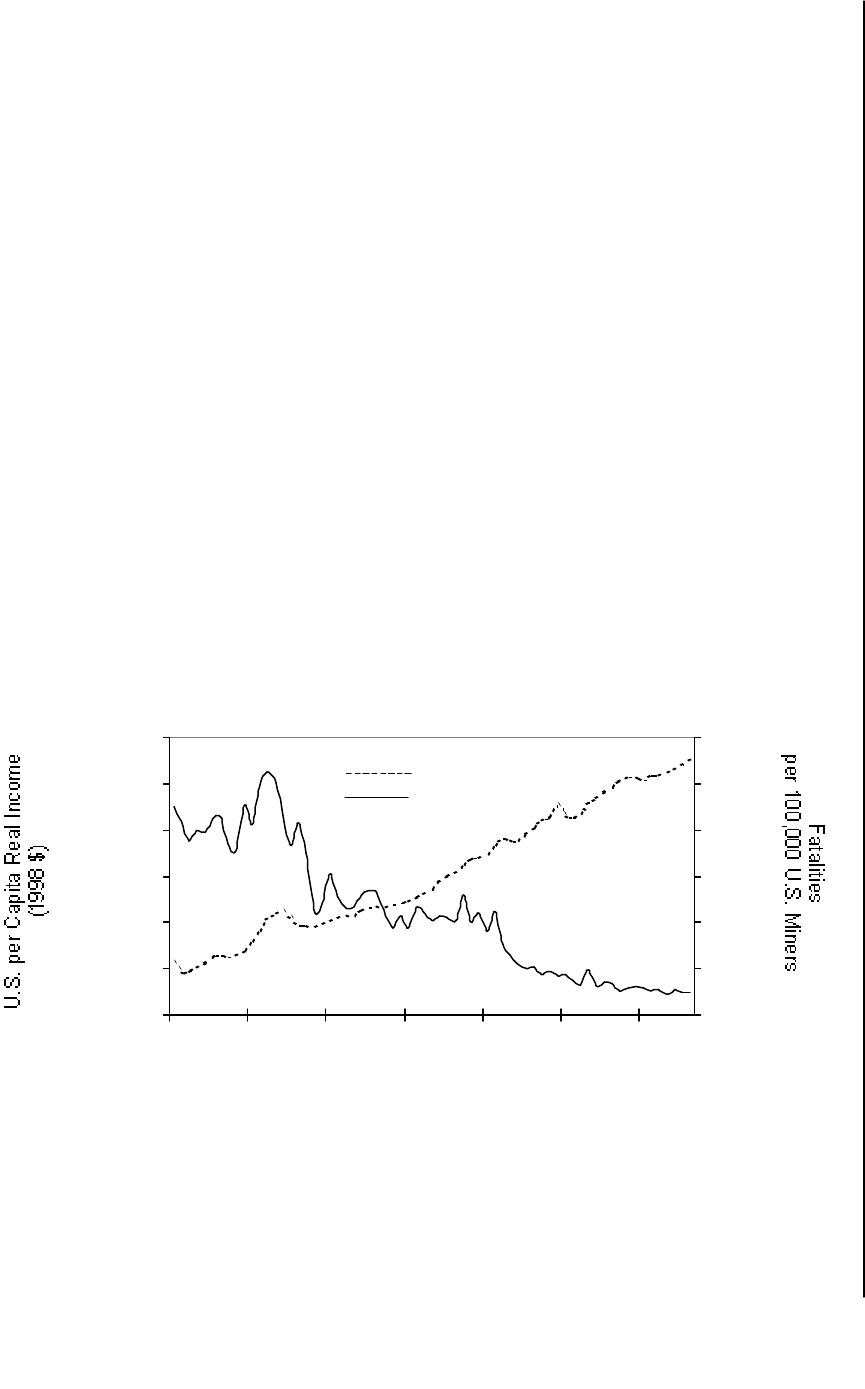
cations of this observation are important: any
social legislation that reduces society’s wealth
by committing society’s scarce resources to
endeavors whose costs do not exceed the ben-
efits is counterproductive. The Mine Act,
which possibly commits more than $7 billion
of society’s scarce resources annually to
achieve no measured benefits in terms of lives
saved, obviously fails this test. Congress
should consider repealing the Mine Act.
The Transition to the
Market Approach to Safety
For the last 25 years, MSHA has success-
fully used scare tactics to oppose all efforts to
repeal or to reform the Mine Act. In 1995, for
example, McAteer stated to Congress:
By repealing the Federal Mine Safety
and Health Act of 1977, and by substi-
tuting a much weaker enforcement
scheme, H.R. 1834 would return us to
an earlier era. Mining communities
remember that era, even if others have
forgotten. Mine explosions were com-
mon. Roof falls were routine. Miners
and their families paid the price.
293
However, given present risk preferences,
advancements in technology, and liability con-
cerns, it is virtually certain that the mining
conditions that existed in the nation’s “earlier
era” are gone forever. Thus, in the mine safety
context, “the fundamental question that we
must address is whether we should continue
to sacrifice additional lives in an effort to pre-
serve this popular mythology.”
294
That is not to say that the transition from
forced compliance to a market-based
approach is guaranteed to be flawless. It may
take time for the regulatory status quo to
unwind. For example, because labor prices are
often locked in by long-term contracts, it
could take as long as a decade for higher labor
costs to accurately reflect the risk-pay prefer-
ences of miners.
0
5,000
10,000
15,000
20,000
25,000
30,000
1931 1941 1951 1961 1971 1981 1991
0
50
100
150
200
250
300
31
In the final analy-
sis, it is probably
a rising standard
of living, more
than anything
else, that reduces
mining fatalities.
Figure 8
Increasing Wealth and Mine Fatality Rates
Sources: For mine fatality rates, author’s calculation ([coal fatalities + metal fatalities] ÷ [number of coal miners
+ number of metal miners]) based on data from U.S. Department of Labor, MSHA Internet, Metal/Nonmetal
Fatalities 1900 [1931] through 2001, www.msha.gov/centurystats/mnmstats.htm; and U.S. Department of Labor,
MSHA Internet, Coal Fatalities for 1900 through 2001, www.msha.gov/centurystats/coalstats.htm. U.S. per capita
income from Bureau of Economic Analysis, Regional Accounts Data, Annual State Personal Income (United
States), www.bea.doc.gov/bea/regional/spi/drill.cfm?table=SA05H&lc=30&years=1957,1956,1955,1954,1953,
1952,1951,1950,1949,1948,1947,1946,1945,1944,1943,1942,1941,1940,1939,1938,1937,1936,1935,1934,1933,1
932,1931,1930,1929&format=htm (converted to 1998 dollars using conversion factor from Consumer Price Index
Conversion Factors to Convert to Dollars of the Year 1998, www.orst.edu/dept/pol_sci/fac/sahr/sahr.htm).
Year
Income
Fatalities

In the unlikely event that mining injuries or
fatalities on a production-rated basis increased
during the transitional period (or even there-
after), Congress might again be pressured by
special interest groups to intervene in the mar-
ket for mine safety. In the event that Congress
succumbs to that pressure, it should resist a
return to the forced compliance model embod-
ied in the Mine Act for all of the reasons dis-
cussed above.
295
To the extent that intervention
may be politically expedient and necessary,
Congress should narrowly tailor its actions to
whatever specifically contributed to the rising
accident rates.
For example, if it was established that min-
ers were not demanding adequate hazard pre-
miums, a system could be put in place to pro-
vide miners with greater information about the
relative risks that they face at the workplace.
296
One information-based approach that the fed-
eral government could take is to make a nation-
al registry of injury statistics available.
297
Such a
registry could contain the injury statistics of
particular mines and mine operators, as well as
necessary ownership and control information.
A miner seeking employment or to change jobs
would access the registry over the Internet and
use it to make a better-informed decision about
possible employment opportunities. For exam-
ple, he might choose to accept a lower rate of
pay, a longer commute, or a complete reloca-
tion in order to work at a mine or for a compa-
ny with better injury rates. Such government
encouragement of safety-based competition
would put less-safe mines and less-safe mine
operators at a disadvantage; eventually they
would be put out of business as compensating
wage differentials made their continued opera-
tion unprofitable.
To the extent it focuses on accident rates,
MSHA’s present Data Retrieval System is a
step in the right direction in this regard, given
that it provides miners with fatal and nonfatal
injury rates at different mining operations.
298
However, substantial refinement would be
required to create a system that provides reli-
able and understandable information to min-
ers about the relative risks faced at competing
mining and even nonmining operations.
299
Moreover, the information collection system
would need to be refined to ensure that the
direct and indirect costs associated with the
collection and dissemination of information
did not outweigh the benefits of such a sys-
tem.
300
Ideally, such a registry might even be
maintained by a nongovernmental entity such
as the National Safety Council.
As another example, Congress might con-
sider offering preferential treatment to mine
operators that meet certain injury thresholds as
a means of encouraging additional investment
in safety if it was established that labor, injury,
insurance, and workers’ compensation costs
did not create sufficient incentives. MSHA
already uses injury thresholds in the issuance of
its annual safety awards to mine operators.
301
However, instead of getting a piece of paper, the
mine operator would get a tangible monetary
benefit for meeting the thresholds. The benefits
could range from lower federal tax rates to
lower royalty rates on resources extracted from
federal lands.
302
Lost tax revenues or royalties
would pale in comparison with the societal
resources lost to forced compliance. Tax breaks
would be preferable to an injury tax because a
tax diverts resources from the private sector,
which can prevent accidents, to government,
which cannot prevent accidents.
303
The Role of Local Law
Enforcement
Regardless of whether or not the federal
government intervenes in the market for
mine safety, there will be operators who will
choose to expose individual miners to hid-
den risks despite the economic incentives to
prevent accidents; and even at mines where
the operator has removed the barriers to safe
behavior, there may be individuals who will
choose to put themselves and others at risk.
Those operators and individuals, to the
extent that their deliberate or reckless choic-
es endanger others, may be appropriate can-
didates for law enforcement. However, to the
extent that law enforcement is necessary and
appropriate, it should be carried out by state
32
To the extent that
law enforcement
is necessary and
appropriate, it
should be carried
out by state and
local govern-
ments, not by
the federal
government.

and local governments, not by the federal
government.
At present the Mine Act provides two law
enforcement mechanisms by which the federal
government can deal with bad actors in the
nation’s mines: civil penalties and criminal
sanctions. Under the Mine Act, MSHA can levy
civil penalties and criminal sanctions not only
against mine operators but also against “corpo-
rate directors, officers and agents,” including
mine foremen, who “knowingly authorized or
carried out such violation.”
304
Because of an
oddity in the Mine Act, the criminal and civil
penalties are not available against directors,
officers, and agents of noncorporate operators
such as sole proprietorships, partnerships, and
limited liability companies.
305
As indicated
above, miners are also largely exempt from fed-
eral law enforcement.
The problem with the present federal
approach, apart from the fact that only a select
minority of the individuals who work in the
nation’s mines are subject to punishment, is that
it usurps local law enforcement. The Mine Act
does not expressly preempt state or local enforce-
ment.
306
Moreover, most state governments have
laws on the books that enable the successful
prosecution of workplace crimes, such as negli-
gent homicide, reckless endangerment, and the
like.
307
Furthermore, most governments of min-
ing states have mine inspectors who are available
to assist local prosecutors with technical mining
issues. Nonetheless, the reality is that active par-
ticipation by federal mine inspectors usually
diminishes the role of state and local authorities
to the point where local law enforcement offi-
cials generally do not meaningfully participate in
mine accident investigations.
308
As a result, deci-
sions about whether to prosecute an entity or an
individual are made by federal mine inspectors
and federal attorneys, and sentencing decisions
are made by federal judges, none of whom have
any relationship with or accountability to the
affected community.
The result of the lack of accountability to
the local populace is incoherent law enforce-
ment, in that actors who should not be penal-
ized are penalized and actors who should be
punished are not punished severely enough.
For example, MSHA has used the Mine Act to
civilly prosecute supervisors for noncriminal
violations of its regulations, even where they did
not intend to violate the law and had only con-
structive knowledge of the violative condi-
tions.
309
On the other hand, the federal govern-
ment has been accused of being lax in punish-
ing the serious malefactors.
310
Those are mis-
takes that local officials who are accountable
and more in touch with the local mining com-
munity may be less likely to make.
311
Therefore,
law enforcement, where necessary, should be
reserved to the states under their existing crim-
inal codes.
The End of a Legacy
A common misperception is that “the
Federal Mine Safety and Health Act is a sib-
ling of the of the OSH Act that applies only
to the mining industry.”
312
In fact, the OSH
Act is a sibling of the Coal Act, which fol-
lowed the Farmington mine disaster. As
McAteer has correctly pointed out, “[T]oday,
thousands upon thousands of workers
beyond the coal industry indirectly owe fed-
eral safety and health protection upon which
they rely to the Farmington disaster.”
313
The legacy of Farmington is that the federal
government now attempts to improve work-
place safety and health for all workers in the
United States through forced compliance,
whereas prior to Farmington it tried to improve
workplace safety and health with information
empowerment. The legalistic approach is now
so firmly embedded in our safety psyche that it
does not even raise eyebrows when the head of
the federal mine safety agency states that “it
ought to be the purpose of the lawyers and of
the mine inspectors [i.e., police] to improve
health and safety.”
314
The simple fact of the matter is that lawyers
and police cannot effectively or efficiently
improve mine safety. Safety has to start and fin-
ish with the individuals who make up the min-
ing industry. For that to happen, the federal
government will have to repeal the forced com-
pliance provisions of the Mine Act.
33
Safety has to start
and finish with
the individuals
who make up the
mining industry.
For that to hap-
pen, the federal
government will
have to repeal the
forced compli-
ance provisions
of the Mine Act.

Notes
1. Federal Mine Safety and Health Act (1977), 30
U.S.C. 802(c) et seq.
2. Robert Reich, quoted in U.S. Department of
Labor, Mine Safety and Health Administration,
“MSHA Commemorates 25th Anniversary of
Coal Act,” News release, March 30, 1995,
www.dol.gov/opa/media/press/msha/msh95110.
htm.
3. J. Davitt McAteer, quoted in ibid.
4. Cass Ballenger, Opening Statement, Hearing
on the Federal Mine Safety and Health Act before
the Subcommittee on Workforce Protections of
the House Committee on Education and the
Workforce, July 30, 1998, http://edworkforce.
house.gov/hearings/105th/wp/msha73098/bal
lenger.hm.
5. Colleen M. O’Neill, “OHSA Plan ‘Should Be
Called Die Act,’” AFL-CIO News, July 3, 1995,
www.aflcio.org/publ/newsonline/95jul3/osha.ht
ml.
6. “But the true toll cannot be calculated in dol-
lars and cents, for behind every number is a neigh-
bor. On June 9, a worker was . . . killed at a
Montana Copper mine, when he fell from the
170-ton haul truck he was repairing.” Robert B.
Reich, Remarks before Subcommittee on
Workforce Protections of the House Committee
on Economic and Educational Opportunities,
June 28, 1995, www.dol.gov/asp/programs/histo
ry/reich/congress/062895rr.htm.
7. Thomas Sowell, Basic Economics: A Citizens Guide to
the Economy (New York: Basic Books, 2000), p. 306.
8. Given that there are human lives and billions of
dollars at stake, no one individual is qualified to
make such a determination. The determination
needs to be made by economists, accountants,
actuaries, statisticians, sociologists, and safety
professionals, preferably ones who have no or lim-
ited vested interest in the Mine Act’s future.
9. See, for example, Contractor’s Sand & Gravel Inc. v.
FMSHRC, 199 F.3d 1335 (D.C. Cir. 2000) (award of
$100,000 in attorney’s fees and expenses against
MSHA in a case involving a vacated citation that
carried a $7,000 civil penalty assessment).
10. The focus of this paper is on the provisions of
the Mine Act that deal with safety regulation,
inspection, and enforcement. The provisions
dealing with health regulation, inspection, and
enforcement; black lung benefits; mandatory
training; and whistleblowers are beyond the scope
of this paper but are worthy of equal scrutiny.
11. Davitt McAteer, “Farmington Victims Left
Legacy to Nation’s Miners,” MSHN [Mine Safety
and Health News] 5 (November 27, 1998): 532.
12. U.S. Department of Labor, “Injury Trends in
Mining,” Fact sheet, MSHA Internet,
www.msha.gov/MSHAINFO/FACTSHET/MSH
AFCT2.HTM.
13. “Explosions never accounted for as much as a
quarter of the miners’ mortality.” Mark Aldrich,
“Preventing ‘the Needless Peril of the Coal Mine’:
The Bureau of Mines and the Campaign against
Coal Mine Explosions, 1910–1940,” Technology
and Culture 36, no. 3 (1995): 518.
14. Chris Stirewalt, “Loss of Life Leads to
Change,” Charleston Daily Mail, February 9, 1999,
www.dailymail.com/static/specialsections/look
ingback/lb0209.htm.
15. Ibid. See also H.R. 91-563, Federal Coal Mine
Safety and Health Act, 91st Cong., 1st sess., October
13, 1969, www.msha.gov/SOLICITOR/COALACT/
69hous.htm (“General Subcommittee on Labor
conducted 10 days of public hearings on coal mine
health and safety proposals. Included in the hearing
record are the views of representatives of operators
of large coal mines; operators of small coal mines;
the coal miners’ union; individual mine workers;
interested parties; and Administration personnel.”).
16. “Only in 1969 was federal legislation dealing
comprehensively with coal mine safety enacted.”
National Research Council, Committee on
Underground Coal Mine Safety, Commission on
Engineering and Research Systems, Towards Safer
Underground Mines (Washington: National
Academy Press, 1982), p. 54.
17. Sowell, p. 308.
18. For an analysis of compensating wage differen-
tials in bituminous coal mining from 1890 to 1930,
see Price V. Fishback, Soft Coal, Hard Choices (New
York: Oxford University Press, 1992), pp. 79–98. But
see Hal Sider, “Safety and Productivity in
Underground Coal Mining,” Review of Economics and
Statistics, May 1983, pp. 225, 231. Sider suggests, but
does not conclude, that at union coal mining opera-
tions where wages are not determined competitively,
a mine operator’s wage costs might be insensitive to
risk.
19. “I will insist on following the rules if I think that
I am going to get hurt or killed or that I may get
someone else hurt or killed [and] I won’t work in
unsafe conditions.” Danny Sheperd, “A Miner’s
34

Perspective of the Ballenger Bill and the Proposed
MSHA/OSHA Cuts,” MSHN2 (June 30, 1995): 362.
20. For an econometric analysis of compensating
wage differentials, see Kip A. Viscusi, Employment
Hazards: An Investigation of Market Performance
(Cambridge, Mass.: Harvard University Press,
1979).
21. For a summary of the literature discussing risk
premiums, see Thomas O. McGarity and Sidney A.
Shapiro, Workers at Risk: The Failed Promise of the
Occupational Safety and Health Administration
(Westport, Conn.: Praeger, 1993), pp. 18-20.
22. It is important to note that this is only an
observation and that a calculation of actual risk
premiums is much more complex. See Viscusi,
Employment Hazards, pp. 42–45.
23. U.S. Department of Labor, Bureau of Labor
Statistics, Career Guide to Industries, 2002–03,
www.bls.gov/oco/cg/cgs004.htm.
24. National Mining Association, Mining
Facts/Fast Facts, www.nma.org/fastfacts.html.
25. David Lauriski, Remarks to 62nd Annual
Meeting of the Kentucky Mineral Law Institute,
reprinted in MSHN 7 (August 31, 2001): 387.
26. “Indirect costs, though hidden, are real and
are estimated to be at least four times the insured
costs.” Dave Carlson, Michigan State Grants
Program, “Barriers to Safe Employee Behavior,”
MSHN 6 (January 22, 1999): 50. “A commonly
accepted figure is that for every dollar that the
insurance carrier pays out on a workers’ compen-
sation claim, the company may have an indirect
expense of around six dollars.” Rob Brooks,
Chubb Group of Insurance Companies,
“Rethinking Mine Safety Management,” MSHN2
(August 25, 1995): 457.
27. “[R]ising injury costs were the spur that goaded
the large metal mines to begin organized safety
work.” Mark Aldrich, Safety First: Technology, Labor
and Business in the Building of Work Safety, 1870–1939
(Baltimore: Johns Hopkins University Press, 1997),
p. 247.
28. “Companies Can Expect Higher Compensation
Insurance,” MSHN 7 (September 1, 2000): 381.
29. Western Mine Engineering, Inc., “U.S. Metal
and Industrial Mineral Mine Salaries, Wages, and
Benefits & U.S. Coal Mine Salaries, Wages, and
Benefits 2000 Survey Results,” 2000.
30. For a summary of changes in employer tort
liability, see McGarity and Shapiro, pp. 18–20.
31. “Widow, Son Sue Baylor Mining for $10
Million in Mine Death,” MSHN 9 (January 21,
2002): 41; “N.M. Supreme Court Allows Employers
to Be Sued for Misconduct in Accidents,” MSHN 8
(October 29, 2001): 480; “Families File First
Lawsuits in Jim Walter Mine Disaster,” MSHN 8
(October 15, 2001): 456; “Lawmakers Want to
Change Wyoming Constitution to Allow Worker
Lawsuits,” MSHN 8 (August 3, 2001): 364; “Worker
Injured in Fall Awarded $6.7 Million by Alabama
Jury,” MSHN 8 (May 25, 2001): 247; “Missouri
Court Reinstates Widow’s Lawsuit against Lone
Star,” MSHN 8 (April 13, 2001): 177; and “Widow
Sues Kentucky Coal Company over Husband’s
Death,” MSHN 8 (January 19, 2001): 46.
32. John D. Worrall says that the incentive for
employers to maintain safe workplaces to avoid
premium increases will be offset to some extent
by the moral hazard created by the compensation
for injured miners. John D. Worrall, Safety and the
Work Force (Ithaca, N.Y.: IRL Press, 1983), p. 154.
According to Price V. Fishback and Shawn E.
Kantor, the limited empirical studies have indi-
cated that in most industries, except notably coal
mining, the incentives for operators to invest in
safety outweighed the moral hazards, resulting in
fewer injuries. Price V. Fishback and Shawn E.
Kantor, A Prelude to the Welfare State (Chicago:
University of Chicago Press, 2000), pp. 77–83.
33. “An experience modification factor (EMF) takes
into account . . . [a mine operator’s] past [insurance]
claims. . . . The EMF is a direct multiplier to your pre-
mium cost so your costs for insurance would be 75%
or 150% of the initial cost depending on your claims
experience.” Carlson, p. 51.
34. With respect to coal mine explosions, “econom-
ic incentives were probably more important than
legal changes in encouraging the spread of rock
dusting, [the practice of covering all surface areas in
the mine with incombustible material, because, in
part] explosions could be extremely expensive, for
they often destroyed the mine.” Aldrich, “Preventing
‘the Needless Peril of the Coal Mine,’” p. 513.
35. For example, Larry Lankton found that
“major fires were very expensive in terms of lost
revenues and large recovery rates.” Larry Lankton,
Cradle to Grave: Life, Work and Death at the Lake
Superior Copper Mines (New York: Oxford
University Press, 1991), p. 120.
36. U.S. Department of Labor, MSHA Internet Site,
History of Mine Safety and Health Legislation,
www.msha.gov/MSHAINFO/MSHAINF2.HTM.
37. Fishback, p. 113. “The Bureau had no power
of inspection or supervision, but was to cooperate
with mining interests, providing them the tech-
35

nological support needed to reduce the ‘needless
perils’ and other wastes of the mining.” Aldrich,
“Preventing ‘the Needless Peril of the Coal Mine,’”
p. 491.
38. “[T]he bureau gradually mastered the art of
prodding operators into implementing the new
technologies that resulted from its scientific
investigations.” Ibid., p. 495.
39. John Mendeloff, Regulating Safety: An Economic
and Political Analysis of Occupational Safety and
Health Policy (Cambridge, Mass.: MIT Press, 1979),
p. 25.
40. Ibid.
41. “Even though miners are afraid of someone
getting killed—rarely do they believe that it could
be them.” Sheperd, p. 363.
42. Viscusi, Employment Hazards, pp. 133, 143. See
also W. Kip Viscusi, Risk by Choice: Regulating Health
and Safety in the Workplace Cambridge, Mass.:
Harvard University Press, 1983), pp. 73–75.
43. Rhea Graham, “Goodbye to an 85 Year Old
Agency; Farewell to Bureau of Mines,” MSHN 2
(November 17, 1995): 623.
44. “These findings demonstrated that virtually all
American bituminous coal dust, if sufficiently fine
and mixed with gas, was highly explosive and
required large amounts of inert material [i.e., pulver-
ized rock dust] to neutralize it.” Aldrich, “Preventing
‘the Needless Peril of the Coal Mine,’” p. 501.
45. Viscusi, Employment Hazards, pp. 133, 143.
46. Fishback, p. 113.
47. See generally Aldrich, Safety First; and Aldrich,
“Preventing ‘the Needless Peril of the Coal Mine.’”
48. For a detailed history of “the federal takeover”
of mining regulation, see James Whiteside,
Regulating Danger (Lincoln: University of Nebraska
Press, 1990), pp. 175–201.
49. For a summary of the history of mine safety
legislation, see ibid and U.S. Department of
Labor, History of Mine Safety and Health Legislation.
50. See Whiteside, pp. 175–201.
51. Walter J. Hickel, secretary of the interior, quot-
ed in H.R. 91-563.
52. “Official figures claim there are fewer than
10,000 mining deaths a year. The real figure is
more likely to be closer to 20,000.” “Coal Mining in
China, Introduction,” China Labour Bulletin,
January–February 2000, http://iso.chinalabour.
org.hk/-iso/article.adp?article_id=1086. “[R]ecent
government moves to match production levels to
slowing consumer demand could see production
in the year 2000 at a level closer to 1,100 to 1,200
million tonnes [run-of-mine].” International
Energy Agency, Coal in the Energy Supply of China,
www.iea.org/pubs/studies/files/coachi/coachi.ht
m#chart.
53. Number of fatally injured coal miners in 2000
from U.S. Department of Labor, MSHA Internet,
Coal Fatalities for 1900 through 2001, www.msha.
gov/centurystats/coalstats.htm. U.S. coal produc-
tion in 2000 from Energy Information Administra-
tion, Coal Industry Annuals, 1994–2000, http://
tonto.eia.doe.gov/FTPROOT/coal/coalpubs.htm.
54. U.S. coal production for 1969 and 1934 from
Energy Information Administration, U.S.
Bituminous and Lignite Coal Production 1900–
1993, 1995, Table 18, pp. 65–66, http://tonto.eia.
doe.gov/FTPROOT/coal/006493.pdf. U.S. anthra-
cite coal production 1900–1993 from Pennsylvania
Department of Environmental Protection 2000
Annual Report on Mining Activities, Table 1,
www.dep.state.pa.us/dep/deputate/minres/
bmr/annualreport/2000/table01.htm. Fatalities
from U.S. Department of Labor, MSHA Internet,
Coal Fatalities for 1900–2001, www.msha.gov/cen
turystats/coalstats.htm.
55. The 91st Congress received technically cor-
rect, but otherwise inaccurate, information
regarding the trend in mine fatality rates from
former department of the interior secretary
Walter J. Hickel, who testified that “there has been
no improvement in the overall fatality rate since
1947.” H.R. 91-563. Although the fatality per
employee rates per 100,000 miners in 1947 (236)
and in 1968 (231) were similar, the 1968 rate,
which reflected the Farmington disaster, was an
aberration. Fatalities in absolute numbers had
been steadily declining since the late 1950s after
rising somewhat in the mid-1950s. U.S.
Department of Labor, MSHA Internet, Coal
Fatalities for 1900 through 2001. See also
National Research Council, p. 15. Moreover,
Secretary Hickel neglected to tell Congress that
the fatality per million ton rate had improved by
more than a factor of three between 1947 (1.7)
and 1968 (.56). Number of U.S. coal mine fatali-
ties from U.S. Department of Labor, MSHA
Internet, Coal Fatalities for 1900 through 2001,
www.msha.gov/centurystats/coalstats.htm,
divided by U.S. total coal production (thousand
short tons) 1900 to 1993 from Energy
Information Administration, U.S. Bituminous
and Lignite Coal Production 1900 to 2000, Coal
Products Publications, Coal Data: A Reference,
Table 18, U.S. Production Trends in Bituminous
36

Coal and Lignite, 1900–1993 (total production,
thousand short tons), 1995, pp. 65–66,
http://tonto.eia.doe.gov/FTPROOT/coal/00649
3.pdf, plus U.S. anthracite coal production 1900
to 1993 from Pennsylvania Department of
Environ-mental Protection, Mining and
Reclamation, 2000 Annual Report on Mining
Activities, Table 1, Anthracite Statistical
Summaries 1870 to 2000 (production, net tons),
www.dep.state.pa.us/dep/deputate/min
res/bmr/annualreport/2000/table01.htm, and
U.S. total coal production 1994 to 2000 from
Energy Information Administration, Coal
Products Publications, Coal Industry Annals
1994–2000 (thousand short tons), http://tonto.
eia.doe.gov/FTPROOT/coal/coalpubs.htm, times
1,000.
56. H.R. 91-563.
57. “[T]he legal background of most congressmen
. . . inclines them to make the reallocation of legal
rights and duties rather than economic incentives
the usual tool for effecting changes in behavior.”
Mendeloff, p. 26. Compare 30 U.S.C. 801(e)
(“operators of such mines . . . have the primary
responsibility to prevent [accidents]”) and 801(a)
(“the first priority and concern of all in the coal or
other mining industry must be the health and
safety of its most precious resource—the miner”);
see also 30 U.S.C. 814(a), 821.
58. U.S. Department of Labor, History of Mine
Safety and Health Legislation.
59. See generally Federal Coal Mine Safety and
Health Act of 1977, Pub. L. 91-73 (1977); and U.S.
Department of Labor, History of Mine Safety and
Health Legislation.
60. “[The Coal Act] allowed ‘first-instance’ penal-
ties, that is, employers could be cited merely for
having a violation, not just for failing to correct
violations cited earlier.” Mendeloff, p. 19.
61. S.R. 95-181, 95th Cong., 1st sess., reprinted in
Subcommittee on Labor of the Senate Commit-
tee on Human Resources, Legislative History of the
Federal Mine Safety and Health Act of 1977, July 1978,
p. 592, www.msha.gov/SOLICITOR/COALACT/
leghist2.htm.
62. Ibid., p. 595.
63. Ibid., p. 592.
64. H.R. 91-563.
65. The UMWA claims that it “convinced
Congress to enact the landmark Federal Coal
Mine Health and Safety Act” in 1969. UMWA
Internet, A Brief History of the UMWA,
www.umwa.org/history/hist1.shtml.
66. Frederic Bastiat, The Law (Irvington-on-Hudson,
N.Y.: Foundation for Economic Education, 1998),
pp. 7–8.
67. H.R. 95-312, reprinted in Subcommittee on
Labor of the Senate Committee on Human
Resources, p. 364.
68. Ibid.
69. Occupational injury incidence rates per
100,000 miners by industry in United States in
1975 and 1976 were anthracite coal 229.2, bitu-
minous and lignite coal 133.9, metal mining 76.9,
private-sector average 57.8, nonmetallic mining
49.8. U.S. Department of Labor, Bureau of Labor
Statistics, “Occupational Injuries and Illness in
the United States Industry, 1978,” Bulletin 2019
(1979): Table 8, p. 79.
70. H.R. 95-312, reprint, p. 364 (citing at length
Frank McGee, treasurer-elect of the United States
Steel Workers of America).
71. “[The UMWA] provided little support for the
bureau [of Mines’] efforts to introduce permissi-
ble explosives and electric cap lamps.” Aldrich,
“Preventing ‘the Needless Peril of the Coal Mine,’”
p. 493.
72. “The appeal of federal action to union leaders
was that it offered a way to bypass the union’s
weak position on these issues in collective bar-
gaining.” Mendeloff, p. 16.
73. H.R. 95-312, reprint, p. 358.
74. U.S. Department of Labor, Bureau of Labor
Statistics, “Occupational Injuries and Illness in
the United States Industry, 1978,” p. 24. Chart 14
ranks the 10 three-digit SIC industries with the
highest injury incidence rate of lost workdays in
1976: water transportation, 452.6; sanitary ser-
vices, 274.6; loggers, 284.5; anthracite coal, 229.2;
private-sector average, 57.8.
75. “The powers not delegated to the United
States by the Constitution, nor prohibited by it to
the States, are reserved to the States respectively,
or to the people.” U.S. Constitution, Amendment
Ten.
76. “To regulate Commerce with foreign
Nationals, and among the several States, and with
the Indian Tribes. . . .” U.S. Constitution, Art. 1,
sec. 8.
77. Pub. L. 91-173, sec. 2(f).
37

78. S.R. 95-181, reprint, p. 590 (discussing federal
takeover).
79. H.R. 91-563 (“Coal is our most abundant fuel
resource. Right now, it supplies nearly a fourth of
our total energy demand and every forecast,
whether by Government or the private sector,
indicates that coal must continue to play a signif-
icant role if this country’s future energy require-
ments are to be satisfied.”).
80. 30 U.S.C. 801(b).
81. 30 U.S.C. 801(c); see also H.R. 91-563 (“it has
also frequently saddened our Nation with news of
crippled men, grieving widows, and fatherless
children.”) (quoting President Nixon).
82. 30 U.S.C. 801(a).
83. Mendeloff, pp. 25–31.
84. Former labor secretary Alexis Herman com-
mented that “Americans workers have a funda-
mental right to a safe and healthful workplace.”
Quoted in “Kaiser, MSHA Agree to $513,000
Settlement with New Safety Measures,” MSHA
News release 2000-1214, December 14, 2000,
www.msha.gov/MEDIA/PRESS/2000/
NR001214.HTM. Reich stated, “If Congress
enacts this legislation, it will be reneging on the
promise it made twenty-five years ago to
America’s workers: the right to a safe and healthy
workplace.” Quoted in “Labor Dept. Denounces
Attempt to Gut Safety Agencies,” MSHA News
release 95-021, June 14, 1995, www.msha.gov/
MEDIA/PRESS/1995/NR950614.HTM. See also
30 U.S.C. 801(a); and H.R. 95-312, reprint, p. 379.
85. “The organized labor movement is the
Department of Labor’s (and OSHA’s [and
MSHA’s]) chief client, and the department is
expected to show at least some partiality to the
interests of organized labor.” Mendeloff, pp. 73–74.
86. 30 U.S.C. 811(a).
87. 30 U.S.C. 813(a).
88. 30 U.S.C. 814(a); 820(a), (c), (d). See also 30
U.S.C. 814(b), (d); 817(a); 821 (authorizing MSHA
to issue orders closing all or part of the mine oper-
ator’s operation and to require the mine operator
to compensate certain miners idled by such
orders in cases involving unwarrantable noncom-
pliance, failure to correct or imminent danger).
89. S.R. 95-181, reprint, p. 596 (“The Committee
believes that there is great need to encourage young
people to go into the occupation of mining as the
need of our nation for the minerals and energy
sources extracted from the earth continues to
increase. It is the Committee’s feeling that the duty of
the Congress, if it is to encourage such employment,
is to make that employment as safe as possible.”).
90. Ibid., p. 593 (“Over the long run, improved
health and safety promotes greater productivity
through reduction of ‘downtime.’”).
91. Ibid. (“Lowered workers’ compensation premi-
ums which should result from improved safety and
health, can be expected to lower production costs.”).
92. 30 U.S.C. 801(d). Emphasis added.
93. J. Davitt McAteer, Testimony before the
Subcommittee on Workforce Protections of the
House Committee on Education and the
Workforce, September 14, 2000, http://edwork
force.house.gov/hearings/106th/wp/msha91400
/mcateer.htm. Emphasis added.
94. Metzgar has pointed out that “[t]he agency
never published analysis of why the fatality rate
declined because it didn’t know.” Carl Metzgar,
“The Map and the Territory: Why the Scientific
Method Is Vital in the Injury Prevention Effort,”
MSHN 3 (May 31, 1996): 296. But see J. Davitt
McAteer, Statement submitted to the
Subcommittee on Workforce Protections of the
House Committee on Economic and Educational
Opportunities on H.R. 1834, the Safety and Health
Improvement and Regulatory Reform Act of 1995,
August 9, 1995, p. 11 n. 2 (citing John Braithwaite,
To Punish or Persuade: Enforcement of Coal Mine Safety
(Albany: State University of New York Press, 1985);
on prior occasions McAteer cited Braithworth in
support of forced compliance even though
Braithwaith does not support the model.
95 McAteer, Testimony of September 14, 2000.
96. U.S. Department of Labor, MSHA, “Reich
Testifies on Proposed Legislation Affecting
OSHA, MSHA Agency Heads Defend Programs,”
Press release, June 28, 1995, www.dol.gov/
opa/media/press/msha/msh95246.htm.
Emphasis added.
97. “Congressman’s Proposal to End MSHA,
OSHA As We Know It,” MSHN 2 (May 5, 1995):
264.
98. McAteer, Statemeent of August 9, 1995, p. 7.
Emphasis added.
99. “Unions Denounce Ballenger Bill in ‘Seven
Days for Safe Jobs’ Protests,” MSHN2 (November
17, 1995): 621.
100. “Ballenger Says MSHA/OSHA Merger Bill Is
Dead—At Least for 1996,” MSHN 3 (March 8,
1996):118.
38

101. Graham, p. 623.
102. “Blasting Formally Studied and Funded at
University of Utah College of Mines,” MSHN 8
(August 3, 2001): 353; and “Nev. Mining School
Gets $100,000 Grant,” MSHN 6 (January 22,
1999): 46.
103. “Present consultive activities of MSHA
should be expanded. . . . However this technical
assistance should be furnished by a part of the
agency outside the normal inspection and
enforcement operations of MSHA.” National
Research Council, p. 20.
104. “UMW Launching Get-Out-to-Vote Drive in
Support of Clinton,” MSHN 3 (March 22, 1996):
144; and “Clinton Promises to Support Unions,
Fight for MSHA/OSHA Budgets,” MSHN 2
(October 6, 1995): 535.
105. U.S. Department of Labor, MSHA, “Reich
Testifies on Proposed Legislation Affecting
OSHA, MSHA,” Press release, June 25, 1995,
www.dol.gov/opa/media/press/msha/msh95246.
htm. “All workers should enjoy the gains in safety
and health achieved for miners by MSHA and the
Mine Act.” McAteer, Statement of August 9, 1995.
106 See, for example, Alcoa Alumina & Chemicals,
L.L.C., 23 FMSHRC 911(September 14, 2001)
(alumina plant); Kinder Morgan Operating LTD “C,”
23 FMSHRC 73 (January 26, 2001) (marine ter-
minal); Jim Walter Resources Inc., 22 FMSHRC 21
(January 31, 2000) (supply warehouse); Cox
Transportation Corp., 22 FMSHRC 568 (April 5,
2000) (public road); and Herman v. Associated
Electric Cooperative Inc., No. 98-1876 (8th Cir. April
20, 1999) (coal-fired electric generating facility).
107. U.S. Department of Labor, MSHA, “President
Clinton Signs International Convention to Raise
Mine Safety and Health Standards Worldwide,”
News release 2001-0110, January 10, 2001; see also
“Clinton Signs ILO Mine Safety Convention,”
MSHN 8 (January 19, 2001): 44.
108. Ibid.
109. McAteer, Testimony of September 14, 2001.
110. This paper, which is designed to bring the
Mine Act under scrutiny, focuses on MSHA’s data
on the number of miners and fatalities. It is impor-
tant to keep in mind, however, that MSHA’s data,
which presumably focus on miners under its juris-
diction, differ somewhat from the Standard
Industrial Classification and Occupational
Classification Systems used by the Bureau of Labor
Statistics. In addition, because of changes in the
manner in which state mining agencies, the Bureau
of Mines, MESA, and MSHA collected and classi-
fied such data throughout the 20th century, pre-
cise historical comparisons, while desirable, are not
always possible.
111. See, for example, McAteer, Statement of
August 9, 1995. The chart attached to the state-
ment depicts a decline in fatalities per work hour
from 1968 forward without showing a decline
prior to 1968.
112. “The questions of causation are subtle in the
extreme and can only be answered by a rigorous
application of the scientific method.” Metzgar,
“The Map and the Territory,” p. 295.
113. Michael Lewis-Beck and John R. Alford, “Can
Government Regulate Safety? The Coal Mine
Example,” American Political Science Review 74
(1980): 745. See also Braithwaite, pp. 81–82, indi-
cating the existence of two unpublished manu-
scripts that are “totally supportive” of the 1980
study; and McAteer, Statement of August 9, 1995,
p. 11 n. 2, citing Braithwaite as proof for the
proposition that “mine inspections save lives.”
114. Lewis-Beck and Alford, p. 749.
115. Ibid., p. 751.
116. Ibid., p. 752.
117. Ibid., p. 751.
118. U.S. Department of Energy, Energy
Information Administration, A Chronology and
Overview of the U.S. Coal Market, www.eia.doe.gov/
cneaf/coal/chron/chronc.html(mining timeline).
“By 1960, 546 U.S. coal mines were using bolts for
support of mine roof and 57 percent of the under-
ground coal product came from under roof sup-
ported in this manner.” Seth D. Woodruff,
Methods of Working Coal and Metal Mines (New York:
Pergamon, 1966), vol. 2, p. 169.
119. “Since this test and others fail to disaggregate
the overall injury rate, they lose a great deal of the
power they might have had.” Mendeloff, p. 165. See
also Carl Metzgar, who says, “The tiles of the injury
picture have to be looked at as individuals as well as
parts of the whole.” Carl Metzgar, “Politics and the
MSHA Statistics,” MSHN3 (June 14, 1996): 330.
120 Lewis-Beck and Alford, p. 752.
121. Ibid., p. 750.
122. See Whiteside, p. 212; Fishback, p. 122; and
Aldrich, Safety First, p. 251.
123. Lewis-Beck and Alford, p. 750.
39

124. “This strong association between fatality rate
and mine size could not be explained by any other
mine characteristics that we examined.” National
Research Council, p. 91. “Technological change
[especially the shift from underground to surface
mining] had as much or more to do with declining
death rates as did regulation.” Whiteside, p. 199.
125. MSHA’s data on the number of miners go back
to 1900, whereas the Bureau of Mines’ man-hour
data go back only to 1932. See U.S. Department of
Labor, MSHA Internet, Coal Fatalities for 1900
through 2001. See also Lewis-Beck and Alford,
p.748.
126. The trends for fatalities per man-hour and
fatalities per miner are not identical but closely
approximate each other. See, for example,
National Research Council, Figure 6, p. 39.
127. “As an old American folk song notes, an
underground coal miner once shoveled ‘sixteen
tons’ a day. In 1993, underground ‘longwall’ coal
miners in the Western United States produced an
average of 5.7 tons of coal per worker-hour.” J.
Davitt McAteer, “Don’t Undermine Mine Safety,”
Multinational Monitor 16, no. 10 (October 1995),
www.essential.org/monitor/hyper/mm1090.05.h
tml.
128. H.R. 95-312, reprint, p. 358 (“Studies have
shown that accelerated emphasis on production
tends to push up both fatality and injury rates
among miners.”). “Mechanization has frequently
been held responsible for heightening the risk of
death in the mines.” Lewis-Beck and Alford, p.
750. Lankton notes the importance of evaluating
fatalities in terms of number of miners and
amount of production. Lankton, p. 124.
129. While this is true for coal, it may not hold for
metal and nonmetal mining. For example, with
respect to gold, from a safety perspective, tons of
earth moved might be a better denominator than
ounces of gold produced because it would more
accurately estimate the exposure to hazards. On the
other hand, fatalities per ounce produced may be a
better social measure since it would indicate which
mines have the highest cost in terms of human lives.
Appropriate measures would have to be devised for
each of the metal and nonmetal groups.
130. “Essentially, the industry is right that the num-
ber of people who have to be killed and maimed to
produce a million tons of coal is the more important
statistic for public policy.” Braithwaite, p. 176.
131. “Thus if workers near the face are at a sub-
stantially greater risk than those away from the
face, large mines would tend to have smaller fatali-
ty rates simply because their workforces include a
greater proportion of low-risk miner than do those
small mines.” National Research Council, p. 91.
132. Sider presents an analysis of productivity
and job safety, measured by injuries per million
man-hours in underground coal mining in
Illinois between 1962 and 1976, using estimation
of an extended Cobb-Douglas production model
that incorporates work-related accidents as a joint
output. Sider, p. 225.
133. “The results indicate that movements along
the product transformation curve relating acci-
dents and marketable output do not account for
the decline in measured productivity. This decline
instead reflects a downward shift of this frontier—
a real decline in potential production of mar-
ketable output. The non-linear pattern in techno-
logical change parameters and differences in these
parameters across technologies indicate that a
variety of factors have influenced productivity
trends including CMHSA [the Coal Act] and the
1974 contract between union and management.”
Ibid., p. 232.
134. National Research Council, pp. 38–39 and
Figure 7, p. 59. Figure 7 shows that “productivity
(measured as output per employee-hour) dropped
substantially between 1970 and 1980.”
135. “The beginning of the downturn in mea-
sured productivity coincides with the implemen-
tation in 1970 of the Coal Mine Health and Safety
Act of 1969.” Ibid., p. 228.
136. In 1996 the rates were 7.29 for China, 0.66 for
Russia, 0.47 for India, 0.23 for South Africa, 0.23
for Poland, and 0.04 for the United States.
“Dangerous Coal Mines Take Human Toll in
China,” New York Times, June 19, 2000.
137. “During a period in 1992, from May 27 to
July 14, the coal mining industry did not experi-
ence any fatal accidents while producing many
million tons of coal—a period of rare length in
mining history.” U.S. Department of Labor,
MSHA Internet, “Injury Trends in Mining.”
138. Sider notes that trends in injuries per ton of
coal mined fell during the 1960s but rose quite
rapidly during the 1970s. Sider, p. 227.
139. “There is no discounting the fact that the
Mine Act and MSHA’s administration of the Act,
coupled with heightened operator awareness of
safety and health considerations, have served to
decrease the incidence of major mine disasters
that once plagued the American mining indus-
try.” Bruce Watemen, National Mining
Association, Testimony before the House
Oversight Hearing on the Federal Mine Safety
40

and Health Act of 1977, September 14, 2000,
http://edworkforce.house.gov/hearings/106th/w
p/msha91400/watzman.htm. The National
Mining Association “does not dispute the contri-
butions that the Mine Act has made to improved
miner health and safety.” “Regulatory Overhaul
and Cooperation Necessary for Industry, Says
NMA,” MSHN 2 (November 17, 1995): 618. But
according to Metzgar, “The combination of the
bias of the Act against operators and unenlight-
ened enforcement have potholed the road to
progress.” Metzgar, ”The Map and the Territory,”
p. 295.
140. Senate Record Vote Analysis, Vote no. 307,
104th Cong., 1st sess., Regulatory Reform/OSHA
and MSHA Exemption, S-99970 Temp. Record, July
14, 1995, www.senate.gov/~rpc/rva/1041/
1041307.pdf.
141. “There are good reasons to believe that OSHA
has had only a limited effect on the number of
industrial accidents and illnesses. Several econo-
mists have suggested that OSHA may not be
responsible for even the decrease in accidents that
has occurred. Worse, there are some indications
that workplaces are actually less safe today than
they were a few years ago.” McGarity and Shapiro,
pp. 10–11. But Braithwaite says that “it is beyond
dispute that, if there were 100 percent compliance
with mine safety laws, the majority of miners who
die in coal mines would be saved.” Braithwaite, p.
75. And the National Research Council asserts that
“enforcement of safety regulations and continuing
improvement of safety regulations are a necessary
part of the overall foundation of a national com-
mitment to improved underground coal mine safe-
ty.” National Research Council, p. 18.
142. Sider found “a small and statistically
insignificant negative decline in accidents during
1970–1976” following passage of the Coal Act.
Sider, p. 231 n. 16.
143. Mendeloff, p. 154.
144. “ALJ Dismisses MSHA Charges in Fatal Rail
Accident Case,” MSHN 8 (February 2, 2001): 66.
145. “Reflective Clothing Might Have Saved Prep
Plant Worker’s Life,” MSHN 7 (April 28, 2000):
197; and “Barrick Goldstrike Not Charged in
Employee Fatality from Fire,” MSHN 1
(September 23, 1994): 483.
146. See 30 C.F.R. 56/57.11001 (“A safe means of
access shall be provided and maintained to all work-
ing places.”); 30 C.F.R. 56/57.3200 (“Ground condi-
tions that create a hazard shall be taken down or
supported before other work or travel is permitted in
the affected area.”); 30 C.F.R. 56/57.12030 (“When a
potentially dangerous condition is found it shall be
corrected before equipment or wiring is energized.”);
and 30 C.F.R. 56/57.14100 (“Defects on any equip-
ment, machinery, and tools that affect safety shall be
corrected in a timely manner to prevent the creation
of a hazard to persons.”).
147. See, for example, Alabama by Products, 4
FMSHRC 2128, 2130 (December 1982)
(“Broadness is not always a fatal defect in a safety
and health standard. Many standards must be
‘simple and brief in order to be broadly adaptable
to myriad circumstances.’”).
148. The advantage of safety performance stan-
dards is that they permit the operator to select the
least costly means of compliance. Viscusi, Risk by
Choice, p. 131. “While some MSHA regulations are
prescriptive, the majority are performance-orient-
ed, which gives mine operators necessary and
desired compliance discretion.” National Stone
Sand & Gravel Association, Policy Papers, MSHA
Enforcement, www.nssga.org/publicpolicy/policy
papers.htm.
149. The 1977 Congress specifically rejected a
general duty clause because it “did not want such
a vague and general duty clause to possibly
become an inspector’s vehicle for harassing and
unjustifiably intimidating well-intentioned coal
operators.” Congressional Record, October 27, 1977,
pp. 11662–68.
150. See, for example, 30 C.F.R. 75.312, 75.332,
75.342, 75.350, 75.360, 75.364, 75.380, 75.503,
75.701, 75.804, 75.900, 75.901, 75.1002, 75.1100-
2, 75.1700, 75.1710-1, 75.1711-1, 75.1726,
75.1905, 77.214(a).
151. See 30 U.S.C. 811(c). “Leer criticized MSHA for
not approving new technologies that the industry
wished to introduce into the mines. ‘In the case of
proven technologies, such as continuous methane
monitoring and enclosed helmets which provide
purer air in intermittently dusty conditions, there
is no justification for retaining current procedural
hurdles to their use.’” “Mine Act, MSHA Changes
Are Needed, Arch Mineral’s President Tells
Institute,” MSHN2 (September 8, 1995): 485.
152. See generally 30 C.F.R. part 44, subpart B.
153. See, for example, Mettiki Coal, 1999-MSA-6 (ALJ
April 7, 2000) (two years); Freeman United Coal Mining
Co., 1998-MSA-10 (ALJ December 15, 1998) (more
than a year); and Consolidation Coal Company, 1993-
MSA-4 (ALJ April 22, 1994) (two years).
154. See, for example, International Uranium
Corporation, 1999-MSA-0003, -0004, -0009 (ALJ
March 2, 2000) (appeals of petition denials by
41

MSHA withdrawn due to mine closure); LEECO, Inc.,
1999-MSA-7 (ALJ December 1, 1999) (appeal of peti-
tion denied by MSHA withdrawn); and Rochester and
Pittsburgh Coal Company, 91-MSA-1 (ALJ August 12,
1994) (appeal of petition denied by MSHA with-
drawn due to mine ceasing production).
155. McGarity and Shapiro concede that “tech-
nology-based standards are not likely to induce
highly innovative changes in health and safety
technologies.” McGarity and Shapiro, p. 296. But
McAteer claims, “Technological advances—driven
in part, by the law—have reduced miners’ exposure
to some risks” McAteer, Statement of August 9,
1995, p. 7. Emphasis added.
156. See, for example, “Miner Was Warned Twice
in One Month about Going under Unsupported
Roof,” MSHN 1 (October 21, 1994): 532.
157. For a discussion of behavior-based safety the-
ory, see Steve Minshall, “An Opportunity to Get
Ahead of the Accident Curve,” MSHN 4 (May 2,
1997): 268.
158. “Current MSHA thinking would have you
believe that the worker has no role in the fatality
problem but that regulated training of the worker
is the complete solution to the fatality problem.
What a delicious bit of sophistry for seizing the
opportunity to inflict further enforcement where
there has not been a demonstrated success.”
Metzgar, “The Map and the Territory,” pp. 296–97.
159. “The safety program at a small mine is often
geared heavily towards regulatory compliance.”
Brooks, p. 454.
160. S.R. 95-181, reprint, p. 606 (“If the purposes
of this legislation are to be achieved, the effort
must be a joint one, involving the miner and his
representative as well as the operator.”).
161. Ibid.
162. 30 U.S.C. 801(e) (“The operators of such
mines with the assistance of the miners have the
primary responsibility to prevent the existence of
such conditions and practices in such mines.”).
163 Mine Safety and Health Administration, Office
of Assessments, Average Special Assessments,
www.msha.gov/PROGRAMS/ASSESS/Outreach20
01_files/frame.htm.
164. It should be noted that, among other things,
sec. 105(c) of the Mine Act protects employees who
report hazardous conditions to MSHA from adverse
actions, such as loss of job, and sec. 103(g) of the act
specifically authorizes miners to request inspections.
30 U.S.C. 815(c), 813(g). MSHA has a toll-free num-
ber and encourages miners to report hazards. See
U.S. Department of Labor, MSHA Internet, MSHA’s
Code-A-Phone, www.msha.gov/codeaphone/codea
phone.htm. Although a discussion of the merits of
the Mine Act’s whistleblower provisions is beyond
the scope of this paper, it is worth noting that even
though the employee initiates the process, he is still
relying on the federal government to address his
safety concerns. The obvious problems with this
approach are that (1) it can be ineffectual, (2) it can
be abused, and (3) it can be detrimental to the reso-
lution of safety issues by miners and mine operators.
165. 30 U.S.C. 813(a).
166. “Proposed Bill Would Endanger Miners,
Mine Safety Chief Says,” MSHA News release 95-
022, June 19, 1995.
167. Cyprus Cumberland Resources v. Secretary of
Labor, 20 FMSHRC 285, 288 (March 19, 1998)
(“These inspectors spend between 3 and 5 days a
week at the Cumberland Mine and normally take
the full quarter to complete the inspection. Thus,
in essence, there is a continuous presence at the
Cyprus’ Cumberland facility of at least two
MSHA inspectors who are performing quarterly
inspections. These two inspectors are assisted by
other inspectors from the Waynesburg field
office, which has two supervisors and approxi-
mately 15 inspectors. In addition, MSHA District
2 Office personnel may also inspect the mine site
during a given quarter. Therefore, there may be as
many as 6 or 7 inspectors at the site on any par-
ticular day.”).
168. McAteer, Statement of August 9, 1995, p. 12.
169. “Obviously, around-the-clock inspector pres-
ence is neither possible nor desirable.” Ibid.
170. “Former MSHA Inspector to Be Sentenced
May 14,” MSHN 3 (March 22, 1996)(bribery):
“Former Inspector Gets 18 Months,” MSHN 3
(May 31, 1996): 290(bribery); “Guilty Plea Replaces
Bribery Trial for Former MSHA Employee,” MSHN
2 (August 25, 1995): 448; “Conspiracy Charge Nets
Six Month Prison Term for Former MSHA
Inspector,” MSHN 2 (June 16, 1995): 324 (bribery);
“Mine Superintendent Says Bribing Inspectors Is a
Long-Time Practice,” MSHN 2 (June 2, 1995): 301;
“Trial Date Set for MSHA Inspector,” MSHN 2
(May 19, 1995): 281 (bribery); and “Fourth MSHA
Inspector Enters Guilty Plea,” MSHN 2 (March 24,
1995): 159 (bribery).
171. “After the accident, MSHA transferred Kirk to
its Denver office where his salary was raised $2,659
per year to $78,179.” Craig Harris, “Mining Official
Concedes Errors, Safety Complaints Had Been
Ignored,” Arizona Republic , August 9, 2000.
42

172. See, for example, “Inspector General’s Office
Targets MSHA, OSHA in Second Asbestos
Probe,” MSHN 7 (September 1, 2000): 364;
“Former MSHA Inspector Admits Falsifying
Reports; Other Charges Dropped,” MSHN2 (June
1, 1995): 324; and “Another Special Investigator
Fired, But One Gets Job Back,” MSHN 3 (October
4, 1996): 538.
173. “One example of these difficulties stems from
the assignment to precious metals operations of
MSHA inspectors who have little or no experience
with the new technology developed in recent years
by the gold mining industry. In other cases, MSHA
has sent inspectors to Western gold mining opera-
tions from coal mining areas in the eastern part of
the country. These MSHA inspectors often lack
even the most basic familiarity with and training in
modern gold extraction techniques.” William G.
Miles, director of loss control, Newmont Gold
Company, Elko, Nevada, Testimony at Hearing on
the Federal Mine Safety and Health Act of 1977
before the Subcommittee on Workforce
Protections of the House Committee on Education
and the Workforce, July 30, 1998, http://edwork
force.house.gov/hearings/105th/wp/msha73098/
miles.htm. See also “Coal ‘Loans’ Inspectors for FY
1998,” MSHN 5 (March 20, 1998): 137.
174. Rawl Sales & Processing Co., 23 FMSHRC 463,
466 (May 2001) (“Since I cannot discern what min-
ing danger threatens miners at home in their beds,
I will not support the Secretary’s gratuitous
demand that Rawl order miners underground for
several hours, who would otherwise be at home, to
conduct an ‘on-shift’ examination to protect
nobody from anything.”) (Commissioner Riley,
writing separately).
175. “He was just like hundreds of thousands of
other blue-collar workers. He never considered
himself exceptional. He was ‘just one of the boys.’
Charlie had more than 15 years experience on the
job, and he knew it well. He knew all the rules. He
knew all the safety regulations . . . and he knew all
the shortcuts around them too.” Phoenix Safety
Management Inc., Charlie’s [Morecraft] Story,
www.charlieonsafety.com/index.html.
176 Venita Branham, coal miner, “Mine Health
and Safety Protection: A Miner’s Views of Dying
Industry,” MSHN (February 9, 1996): 73.
177. Sheperd, p. 363.
178. See, for example, Fleming v. United States, No.
2:98-00215 (WV 1999); Ferguson v. United States,
No. 4:91-CV-83-M (KY 1996); Deel v. United States,
No. 94-0166-A (WV 1996); Estate of Denny
Bernaldes v. United States, No. 95-1905 (4th Cir.
1996); Lanny Belcher v. United States, No. 94-0240-B
(VA 1993); and Meyers v. United States, No. 95-5812
(6th Cir. 1994).
179. “Elkins, Brooks Sentencing Wraps Up
Government Case in Southmountain,” MSHN 2
(September 22, 1995): 506; “Smoking Materials, Not
Equipment Caused Day Branch Explosion,” MSHN
2 (July 14, 1995): 388; and “Butane Lighter and Lack
of Stoppings Led to A.A. & W. Explosion,” MSHN 2
(January 13, 1995): 16.
180. 30 U.S.C. 815(b)(1)(B), 820(i).
181. Mine Safety and Health Administration, Office
of Assessments, Average Regular Assessments,
www.msha.gov/PROGRAMS/ASSESS/Outreach20
01_files/frame.htm.
182. 30 C.F.R. 100.4 (establishing mandatory
minimum of $55 for non-significant-and-sub-
stantial violations that are abated in good faith).
183. “The ineffectiveness of fines as sanctions
against coal mining companies in the United States
is clear.” Braithwaite, p. 89. See also Lee Ann Benson,
“The Most Precious Product of A Mine,” Southeast
Ohio Magazine, Fall 1982, www.ohiou.edu/southeast
ohio/marchives/archivef1.html. “Many observers,
however, have expressed skepticism about OSHA’s
deterrent force.” Mendeloff, p. 87.
184. February 21, 2001, facsimile response from
MSHA to Freedom of Information Act request.
185. Viscusi estimated that compensating wage
differentials for all industries were near $70 bil-
lion in 1983. Viscusi, Risk by Choice, p. 3.
186. Mendeloff notes that the small size of the
deterrent may nevertheless generate substantial
compliance activity. Mendeloff, p. 93. But Viscusi
points out that an agency’s impact on safety and
health is a separate question from an agency’s
impact on an industry. Viscusi, Risk by Choice, p. 33.
187. After an explosion at Kaiser’s alumina facili-
ty that injured 29 employees, Kaiser paid
$513,000 to MSHA in fines but had to spend
$275 million to rebuild the plant. John Stucke,
“Kaiser Powers Up Gramercy Facility,” United
Steelworkers of America Local 329 Internet,
December 2000, www.uswa329.org/December_
2000/dec15b.htm.
188. See, for example, U.S. Department of Labor,
MSHA, “Magma Copper Co., Contractor Fined
over $2 Million in Mine Deaths,” MSHA press
release 94.387, August 5, 1994.
189. Mine Safety and Health Administration, Office
of Assessments, Average Special Assessments,
43

www.msha.gov/PROGRAMS/ASSESS/Outreach
2001_files/frame.htm.
190. For a discussion of injury taxes, see Mendeloff,
pp. 25–31.
191. Sunny Ridge Mining Company Inc., 19
FMSHRC 254, 276 (February, 1997) (“I am trou-
bled by the indecipherable criteria used to calcu-
late the appropriate sanction. The judge’s penalty
assessment is not based on any discernable math-
ematical formula nor supported by any compre-
hensible legal rationale and is therefore unreview-
able.”) (Commissioner Riley dissenting).
192. “There were no violations found in a recent
haulage accident.” “Reflective Clothing Might
Have Saved Prep Plant Worker’s Life,” p. 197; see
also “Barrick Goldstrike Not Charged in Employee
Fatality from Fire,” MSHN 1 (September 23, 1994):
483.
193. “The [administrative law judge] declined to
use the agency’s special assessment as a ‘guide-
line,’ because MSHA refused to explain its special
penalty assessment process. However, in its peti-
tion, the agency said it was improper for the ALJ
‘to coerce an inquiry into [MSHA’s] decision-
making process’ and added that an ALJ ‘has no
need to inquire into how, why, or by whom
[MSHA’s] penalty decision was made.’” “Trucking
Company Penalty before FMSHRC for Third
Time,” MSHN 9 (February 18, 2002): 75.
194. “The agency had initially proposed penalties
totaling $700,000 against Dynatec arising from a
fatal accident and has ended up accepting a
$20,000 penalty for a violation of the safe access
rule resulting from ‘moderate negligence.’”
“Dynatec, MSHA Settle Litigation Arising from
Fatal Chute Collapse,” MSHN 8 (December 10,
2001): 532.
195. “Interview of Davitt McAteer by Mine Safety
and Health News,” MSHN1 (February 11, 1994): 62.
196. Jerry Davidson, “Prince of Pork Grabs
Colorado Jobs,” MSHN 3 (August 9, 1996): 453;
and “GAO Asked to Investigate Denver Move:
Reich Told to Put Move on Hold,” MSHN 3
(September 20, 1996): 511.
197. “This technical assistance should be furnished
by a part of the agency outside the normal inspec-
tion and enforcement operations of MSHA.”
National Research Council, p. 19. Cf. “MSHA has
little or no interest in injury prevention. It is inter-
ested in enforcement and punishing operators. . . .
The statistical branch has to be separated from the
enforcement scheme.” Metzgar, “Politics and the
MSHA Statistics,” p. 328.
198. J. Davitt McAteer, “Remarks before the Eastern
Mine Law Foundation Special Institute,
Washington, D.C.,” MSHN1 (March 25, 1994): 145.
199. Attorneys warned mine operators about
MSHA’s police powers. See, for example, Michael
Heenan, Heenan, Althen & Roles, “Document
Requests by MSHA: Pitfalls for Operators,”
MSHN 3 (March 8, 1996): 119; Greg Ruffennach,
“Mine Accident Investigations: What Every
Operator Should Know,” MSHN 3 (June 1996):
356; and “What You Say Can and Will Be Used
against You, Attorney Warns Supervisors,” MSHN
2 (September 22, 1995): 510.
200. “Continued endorsement of the misguided
policies . . ., combined with selected zealous
enforcement indicates a continuance of an unrea-
sonably confrontational atmosphere.” Bobby
Jackson, “McAteer’s MSHA at the Mid-Term,”
MSHN 1 (September 9, 1994): 456. The Mine Act
“begs adversarial relationships between affected
parties.” Ford B. Ford, “Differences Can Be
Resolved at Mine; Leave Big Issues for the Court,”
MSHN 1 (April 8, 1994): 169.
201. “The threat of punishment can have a chilling
effect on the information-gathering process.”
Braithwaite, p. 99. “The insensitive, invective
enforcement of the laws and the creative develop-
ment of a legal theory to sustain a citation and
punish at all costs has dried up the very informa-
tion that would help prevent injuries.” Metzgar,
“Politics and the MSHA Statistics,” p. 331. See also
“Industry Calls for Cooperation at Congressional
Hearing,” MSHN 7 (September 15, 2000): 391.
202. “When there is a willingness to do the right
thing, across-the-board punishment is simply not
the best strategy for maximizing compliance . . .
this is the very mistake that the U.S. Mine Safety
and Health Act perpetuates.” Braithwaite, p. 99.
“An inappropriate focus on blame forces people to
be apprehensive and defensive.” Lauriski, p. 387.
203. “McAteer Says MSHA, Industry Can’t Rest
until Accidents Are Brought Down,” MSHN 3
(May 31, 1996): 296.
204. “Lauriski Open to New Ideas to Decrease
Fatalities and Accidents,” MSHN 8 (July 6, 2001): 307.
205. Number of U.S. coal fatalities plus number of
U.S. metal/nonmetal fatalities. Coal fatalities from
U.S. Department of Labor, MSHA Internet, Coal
Fatalities for 1900 through 2001, www.msha.gov/
centurystats/coalstats.htm; metal/nonmetal fatali-
ties from U.S. Department of Labor, MSHA
Internet, Metal/Nonmetal Fatalities 1900 [1911]
through 2001, www.msha.gov/centurystats/mnm
stats.htm.
44

206. “I do not believe the maxim that says all
injuries are preventable.” Minshall, p. 269. But see
“Mining Deaths Drop Overall in 2000,” MSHA
News release. 2001-0104, January 4, 2001.
207. U.S. Department of Labor, Department of
Labor Budget Overview 2002, www.dol.gov/_sec/
Budget2002/budgetfy2002.htm#msha.
208. Ibid.; compare Contractor’s Sand & Gravel Inc. v.
FMSHRC, 199 F.3d 1335 (D.C. Cir. 2000) (January
2000) (MSHA technical support personnel used as
expert witnesses to support MSHA’s enforcement
position); Dynatec Mining Corporation, 20 FMSHRC
1058 (September 1998) aff’d in part rev’d in part
23 FMSHRC (January 2001) (same).
209. Federal Mine Safety and Health Review
Commission, Fiscal Year 2001 GPRA Annual
Performance Plan and Fiscal Year 1999 Annual
Program Report, www.fmshrc.gov/plans/2002gpra.
html.
210. In FY 2000, $246 million was budgeted; there
were 20,000 inspections. U.S. Department of
Labor, MSHA, MSHA’s Statutory Functions,
www.msha.gov/MSHAINFO/MSHAINF1.HTM.
211. In FY01, $246 million was budgeted and
there were 132,000 assessed violations. U.S.
Department of Labor, Department of Labor
Budget Overview 2002
212. Ibid; U.S. Department of Labor, MSHA
Internet, Metal/Nonmetal Fatalities 1900 to
2001; and U.S. Department of Labor, MSHA
Internet, Coal Fatalities 1900 to 2001 ($246 mil-
lion budget, 350,413 miners in FY01).
213. Mendeloff notes, “The budget of the public
safety agency constitutes a small part of the
resources used in the effort to prevent injuries.
The largest component of these social costs is the
compliance costs incurred by employers.”
Mendeloff, p. 123. “MSHA estimates that the
yearly compliance costs (annualized costs plus
annual costs) resulting from the final rules will be
approximately $17.94 million, of which about
$16.55 million will be borne by the affected non-
metal mine operators.” Final Regulatory
Economic Analysis and Regulatory Flexibility
Analysis for the Final Rule on Training and
Retraining of Miners Engaged in Shell Dredging
or Employed at Sand, Gravel, Surface Stone,
Surface Clay, Colloidal Phosphate, or Surface
Limestone Mines, September, 1999,
www.msha.gov/ REGS/FLEX/99-25273.pdf.
214. Melinda Pon, chairman, NMA’s Occupational
Health Subcommittee, quoted in “Regulatory
Overhaul and Cooperation Necessary for Industry,
Says NMA,” MSHN 2 (November 17, 1995): 619.
215. “The impact of this sort of presence cannot
be ignored because it also means that hourly
employees and management employees are taken
away from their normal duties every day to
accompany the inspectors. . . . Present inspection
procedures are disruptive and time-consuming.”
Wateman.
216. 30 C.F.R. 77.701; and San Juan Coal Company, 13
FMSHRC 1688, 1692-1700 (October 21, 1991) (cita-
tions vacated after trial).
217. Federal Mine Safety and Health Review
Commission.
218. “[A]fter three years and nearly a million dol-
lars in legal defense fees, MSHA’s unjustified pol-
icy change remains pending before the MSHA
Review Commission.” Miles.
219. S.R. 95-181, reprint, pp. 632–33 (“the need to
save litigation and collection expenses should play
no role in determining settlement amounts”); see,
for example, Contractor’s Sand & Gravel Inc. v.
FMSHRC, 199 F.3d 1335 (D.C. Cir. 2000) (January
2000)(MSHA paid more than $100,000 to cover the
mine operator’s attorney fees pursuant to the Equal
Access to Justice Act.).
220. “The net result is an enormous drain on the
resources of the agency for the imposition of what
are puny fines.” Braithwaite, p. 111.
221. Executive Order no. 12866, 58 FR 51735,
1993 WL 388305 (President Clinton) (requiring a
Regulatory Economic Analysis for any rule having
major economic consequences); see, for example,
Final Regulatory Economic Analysis and
Regulatory Flexibility Analysis for the Final Rule
on Training and Retraining of Miners Engaged in
Shell Dredging or Employed at Sand, Gravel,
Surface Stone, Surface Clay, Colloidal Phosphate,
or Surface Limestone Mines.
222. Joseph M. Johnson, “A Review and Synthesis
of the Cost of Workplace Regulation,” George
Mason University, Mercatus Center, August 30,
2001, p. 21, www.mercatus.org/ Workplace.pdf.
223. Ibid. Compare S.R. 195-181, reprint, p. 645
(the 1977 Congress operated under the assump-
tion that it would cost the mining industry $69.15
million per year [1977 dollars] to comply with the
Mine Act). But see also Senator Schmitt stating
that there was not agreement regarding the “accu-
racy” of the estimate. “Floor Debate on Federal
Mine Safety and Health Act of 1977,” Congressional
Record, June 20, 1977, pp. 10203-38.
224. For total contractor and operator NFDL
injuries for both coal and metal/nonmetal, see U.S.
Department of Labor, MSHA Internet, Mining
45

Industry, Accident, Injury and Employment
Statistics, www.msha.gov/ACCINJ/accinj.htm.
225. “Each time I approve a major fine against a
company—for safety violations that were discov-
ered after an accident that cost the life of an
employee—I can’t help but feel a twinge that if we
had just worked harder on prevention, we wouldn’t
be in the impossible position of trying to calculate
the value of a lost human life.” Elaine L. Chao, sec-
retary of labor, Remarks at Welcoming Ceremony,
U.S. Department of Labor Francis Perkins
Building, March 6, 2001, www.dol.gov/_sec/med
ia/speeches/000306chao.htm.
226. For example, “The Agency does not have much
experience in quantifying benefits in the case of a
proposed health standard. . . .” Department of
Labor, MSHA, Proposed Rule, Preliminary Regula-
tory Economic Analysis Health Standards for Diesel
Particulate Concerning: 30 CFR, parts 70 and 75,
Underground Coal Mines, March 1998, www.msha.
gov/REGS/FLEX/PARTIC.HTM#03.
227. For a discussion of various valuation meth-
ods, see McGarity and Shapiro, pp. 270–72.
228. McGarity and Shapiro specifically refer to
health regulations. Ibid., p. 297.
229. “What worries me is that we are becoming an
uncaring nation. We are making lack of compas-
sion acceptable in this country. I just cannot sit
up there and diminish safety of the workplace.”
Rep. Frank Mascara (D-Pa.), quoted in “Ballenger
Unclear on Some of His Own Bill’s Regulatory
Provisions,” MSHN2 (July 28, 1995): 415.
230. McGarity and Shapiro, p. 278.
231. Ibid., p. 295.
232. “There are good reasons why OSHA should
not be restricted by a cost-benefit test, the most
important of which may be that cost-benefit
analysis ignores the distributional consequences
of regulatory policy.” Ibid., p. 294.
233. Sowell, p. 10.
234. “Truck drivers have more work-related fatalities
than any other occupation, accounting for 14% of all
job-related fatalities in 1988.” Peggy Suarez, “The
Unforgiving Road: Trucker Fatali-ties,
Compensation and Working Conditions,” Bureau
of Labor Statistics, Winter 1999, www.bls.
gov/opub/cwc/1999/Winter/art4full.pdf. Fatali-ties
per 100,000 workers (based on Occupational
Classification System) in 1998 were as follows: tim-
ber cutters, 141.6; fishers, 137.3; structural metal
workers, 82.5; aircraft pilots, 80.5; extractive occupa-
tions, 48.0; truck drivers, 29.2.
235. For unintentional injuries to persons aged 1–14
years, see Centers for Disease Control, National
Center for Injury Prevention and Control Home
Page, www.webapp.cdc.gov/ sasweb/ncipc/mor
trate.html.
236. “The simplest accurate statement about the
beneficiaries of OSHA’s programs is that they are
overwhelmingly blue collar workers, mostly
unionized, and mostly men. Support for OSHA
based on a concern with income distribution and
improving the lot of the least fortunate does not
seem well grounded.” Mendeloff, p. 35.
237. “Few people think about using up society’s
resources; they ask who will pay.” Ibid., p. 31.
238. 30 U.S.C. 801(e), (d).
239. Mendeloff notes “the strong likelihood that
least some and perhaps all of the added costs will
be passed on to consumers.” Mendeloff, p. 57.
“We have seen that in the United States, fines are
. . . generally passed on in higher energy costs to
the community as a de facto royalty on the cost of
each ton of coal.” Braithwaite, p. 165.
240. National Mining Association, “Facts about
Mining,” www.nma.org/fastfacts.html.
241. “MSHA Questioned about Possible
Lobbying Efforts by Career Employees,” MSHN2
(June 30, 1995): 359; but see “Hugler, Other
MSHA Employees Cleared of Charges of Illegal
Lobbying,” MSHN2 (December 1, 1995): 647.
242. “The average grade and salary of a mine
inspector is GS 12/5, at $58,031 per annum or $28
($27.90) per hour.” U.S. Department of Labor,
MSHA Internet, 1219-0103 Supporting Statement,
www.msha.gov/regs/fedreg/paperwork/2000/00-
8243.htm.
243. MSHS employees represent 2,310 full-time
equivalents. U.S. Department of Labor, Department
of Labor Budget Overview 2002.
244. Davidson, p. 453; and “GAO Asked to
Investigate Denver Move.”
245. “Unions Denounce Ballenger Bill in ‘Seven
Days for Safe Jobs’ Protests.” A UMTA leader has
stated that “without it [i.e., the Mine Act] there’s
no reason to believe that the mining industry
won’t revert back to the bad old days when it was
common for miners to pay for their jobs with
their lives.” “Assaults on MSHA Play Fast and
Loose with Miners’ Lives,” MSHN 2 (May 19,
1995): 286
246. Richard Trumka, quoted in “Ballenger
Unclear on Some of His Own Bill’s Regulatory
Provisions.”
46

247. Bastiat, p. 8.
248. “[T]he appeal of federal action to union lead-
ers was that it offered a way to bypass the union’s
weak position on these issues in collective bar-
gaining.” Mendeloff, p. 16.
249. Compare “UMWA Call for MSHA
Investigation into Massey Energy’s Health and
Safety Record,” MSHN 8 (July 20, 2001): 334, with
“UMWA Miners Renew Campaign against
Massey Energy,” MSHN 8 (May 25, 2001): 244.
250. Brooks, p. 454.
251. “The Kentucky Coal Assn., Coal Operators and
Associates (Ky.), Lignite Energy Council (N.D.),
Pennsylvania Coal Assn., Texas Mining &
Reclamation Assn., West Virginia Mining and
Reclamation Assn., West Virginia Coal Assn.,
Alabama Coal Assn., Indiana Coal Council, Coal
Producers Committee of Assn. of Oklahoma
General Contractors and the Ohio Mining and
Reclamation Assn . . . stated that the ‘federal govern-
ment has gotten too large and too intrusive in our
day-to-day affairs’ and that MSHA ‘is a clear case in
point.’” “Support for Ballenger Bill Keeps Growing
As Groups Rally for MSHA Overhaul,” MSHN 2
(November 17, 1995): 620.
252. “The American Iron Ore Assn., American
Portland Cement Alliance, Institute of Makers of
Explosives, National Aggregates Assn., National
Industrial Sand Assn., National Mining Assn.,
National Stone Assn., and the Sorptive Mineral
Institute . . . state that they support making MSHA
and OSHA ‘more helpful and effective and less puni-
tive.’” “BCOA Silent on H.R. 1834 Position; Other
Groups Go on Record,” MSHN2 (October 20, 1995):
554. “The National Stone Assn. said while it endors-
es the Ballinger bill, it wants to see its own provisions
included, and the group said it will follow the bill
through the mark-up process to determine whether
continued support of the legislation is appropriate.
The NSA has recommended 13 changes to the bill.”
“Support for Ballenger Bill Keeps Growing As
Groups Rally for MSHA Overhaul,” p. 620.
253. “While staff of the National Mining Assn.
have been meeting with members of the Heritage
Foundation and discussing the possibility of
merging MSHA and OSHA, NMA President
Richard Lawson said the association does not
support any merger of the two agencies at this
time.” “Mining Association Not Supporting
MSHA/OSHA Merger at This Time,” MSHN 2
(February 24, 1995): 111.
254. “The U.S. mining industry is subject to one of
the most burdensome mine safety laws in the
world. As a consequence, our mining is at a com-
petitive disadvantage with foreign operators that
are not subject to command and control health
and safety standards.” Melinda Pon, quoted in
“Regulatory Overhaul and Cooperation Necessary
for Industry, Says NMA,” MSHN 2 (November 17,
1995): 618.
255. “One NMA staffer said that the association’s
position never changed. That the Ballenger bill is
a start for reform but a repeal of the Mine Act is
not appropriate.” “NMA Swings into Action for
MSHA Reform; Some Members Unhappy with
Campaign,” MSHN2 (September 22, 1995): 511.
256. “The seven groups do not oppose an
MSHA/OSHA merger and should a merger take
place, they want mining regulations separate from
general industry OSHA regulations. They would
like to see a separate office for mine safety and
health in OSHA with employees having significant
mine-related experience and training.” “BCOA
Silent on H.R. 1834 Position; Other Groups Go on
Record.” “Like the coal industry groups, NSA sup-
ports a separate mine division of OSHA, but also
wants language whereby there will be a separate
coal division and metal/nonmetal mining divi-
sion.” “Support for Ballenger Bill Keeps Growing
As Groups Rally for MSHA Overhaul.”
257. “A third NMA member said ‘the system
works.’” “NMA Swings into Action for MSHA
Reform,” p. 511.
258. “On its face the [BCOA] ‘position paper’ seems
to take a position, without taking a position.”
“UMW Vice President for Health and Safety Joe
Main said . . . the BCOA position that was represent-
ed to us was one of non-support for the Ballenger
legislation and one of addressing reforms through
the administrative versus legislative process.”
“BCOA Silent on H.R. 1834 Position,” p. 555.
259. “Responsible, health and safety conscious
operators will be forced out of business by price
competition from undercapitalized, irresponsible
operators who will sacrifice the health and safety
of their workers in order to cut their production
costs. . . . Substantial penalties should be applied
regardless of the mine capitalization choices
made by that operator.” Representative of
Westmoreland Coal Company, quoted in
“Westmoreland, American Electric Power
Support MSHA in Letters to Congress,” MSHN2
(June 30, 1995): 360. “National Mining Assn.
President Richard Lawson . . . said that NMA wor-
ries that merging the two agencies could reduce
inspection and enforcement activities, allowing
for the proliferation of fly-by-night operators who
don’t invest in worker safety and health.”
“Ballenger Unclear on Some of His Own Bill’s
Regulatory Provisions,” p. 415.
260. Brooks, p. 454.
47

261. Because work-related accidents are an eco-
nomic bad, reallocating inputs from output-pro-
ducing to accident-reducing activity does not nec-
essarily decrease and may actually increase total
marketable output. Sider, pp. 225–27. “The bot-
tom line is that to remain competitive, safety and
health must be a company value.” Carlson, p. 51.
262. “NMA Accuses National Safety Council of
Not Reaching Consensus on H.R. 1834,” MSHN2
(December 1, 1995): 646.
263. Ibid.
264. Ibid.
265. “The safety director felt that ‘in a direct way
OSHA hasn’t done anything to improve our safe-
ty record—we already had a first-rate program—
but it helped me . . . if the expenditure is necessary
to comply with OSHA, I don’t need to show what
the benefits will be. If it’s just something that I
think we ought to have, then I have to review past
accidents and show how it will prevent reoccur-
rences.’” Mendeloff, p. 91.
266. Carlson, p. 51.
267. Branham, p. 73.
268. Sheperd, p. 362.
269. Branham, p. 74.
270. Ibid.
271. Sheperd, p. 361.
272. Ibid., p. 262.
273. Branham, p. 74.
274. “The scientific method and the rigor and
integrity it demands is terribly embarrassing and
inconvenient to the politician, regulator and dem-
agogue.” Metzgar, “The Map and the Territory,”
p. 294.
275. Branham, p. 73.
276. Sheperd, p. 363.
277. See generally Fishback; and Lankton.
278. Jason Schachter, “Current Population Reports,”
Geographical Mobility: Population Characteristics, March
1999 to March 2000, U.S. Bureau of the Census, May
2001, www.census.gov/prod/ 2001pubs/p20-
538.pdf.
279. Federal Reserve System, “The Exceptional
1990s,” National Economic Trends, March 2000,
www.stls.frb.org/docs/publications/net/2000/co
ver3.pdf.
280. “A Shortage of Trained Miners May Make
Bust of Possible Boom,” MSHN 8 (April 13, 2001):
176; and “Company Looking for Coal Market
Could Employ Up to 300,” MSHN 7 (September
15, 2000): 399.
281. “Since risky jobs become unattractive the
higher one’s income class, we should expect that
many of those who are most outspoken on policy
issues will consider the jobs of workers in haz-
ardous industries abhorrent.” Viscusi, Risk by
Choice, p. 80. “Without being easily able to rely on
their own personal appraisal of the risk, they are
placed in a more paternalistic position.”
Mendeloff, p. 160.
282. “There are no mines inside the Washington,
D.C. Beltway.” McAteer, “Don’t Undermine Mine
Safety.”
283. See generally Aldrich, Safety First, pp. 224–29,
237, 251–55; Whiteside, p. 204; and Lankton, pp.
93–125.
284. “It is common to hear employees at all levels
of an organization talk about their safety rules
and procedures as MSHA or OSHA mandates or
regulations. Their language implies that the
‘stuff’ that they do for safety is more for MSHA or
OSHA than for themselves.” E. Scott Geller,
“Behavior Change Tools to Achieve a Total Safety
Culture,” MSHN 2 (March 24, 1995): 164.
285. “The owners, management and miners of
this mine speak as one. Miners and management
feel MSHA has kept them off guard, that MSHA
is an agency which is actually bringing about poor
safety at the Sixteen to One because of its behav-
ior.” Original Sixteen to One Mine, Inc,
International California Mining Journal: Original
Sixteen to One Goes to Court-Challenges MSHA
Citations, May 13, 2002, www.origsix.com/
mag.asp?id=50.
286. “Efforts to promote present risk regulations
on the basis that they enhance worker rights are
certainly misguided.” Viscusi, Risk by Choice, p. 80.
“Other losers are workers who prefer facing job
hazards . . . [and] workers who have to surrender
risk premiums.” Mendeloff, pp. 32–33.
287. “Convention 176 enhances the ability of the
U.S. mining industry to compete on a more level
playing field in the global economy.” “President
Clinton Signs International Convention to Raise
Mine Safety and Health Standards Worldwide,”
MSHA News release 2001-0110, January 10, 2001.
48

288. Viscusi concludes, “Penalizing workers in
less-developed countries by not buying their
products will not boost their welfare.” Viscusi,
Risk by Choice, p. 52.
289. McAteer, Statement of August 9, 1995, p. 7.
290. “As Americans become wealthier, risk levels
of all kinds have declined.” Viscusi, Risk by Choice,
p. 28.
291. McGarity and Shapiro, p. 296.
292. Sowell, p. 307.
293. McAteer, Statement of August 9, 1995, pp.
3–4; see also Richard L. Trumka, president,
United Mine Workers of America, “Assaults on
MSHA Play Fast and Loose with Miner’s Lives,”
MSHN 2 (May 19, 1995): 286.
294. Viscusi, Risk by Choice, p. 168.
295. In contrast, Braithwaite contends, “The best
approach . . . would be to have a reverse sunset clause
for all deregulatory initiatives. That is, a set of regula-
tions would be placed in abeyance for, say, five years.
If during that five years, industry demonstrated good
faith in making self-regulation work, the regulatory
agency would permanently repeal the regulations; if
not, they would automatically come back into force
after the trial period.” Braithwaite, p. 124.
296. “Providing job risk information to workers
to enable them to select jobs that are appropriate
for their own risk preferences is a promising strat-
egy for augmenting market forces and promoting
outcomes that are responsive to the diversity of
attitudes towards risk.” Viscusi, Risk by Choice, p. 4.
297. The National Research Council suggests that
the government “encourage publication of annu-
al rankings of companies by injury rates.”
National Research Council, p. 15.
298. MSHA Internet, Data Retrieval System,
www.msha.gov/drs/drshome.htm.
299. “Individual facts are as important as the accu-
mulated numbers which make up the statistical
abstraction.” Metzgar, “Politics and the MSHA
Statistics,” p. 329; see also Viscusi, Risk by Choice, p.
158.
300. At present, mine operators report injuries
under existing MSHA regulations. 30 C.F.R. part 50.
Moreover, there are already strong federal laws in
place that prohibit false reporting. See, for example,
30 U.S.C. 820(f). To avoid reporting controversies
altogether, the federal government might collect
such injury information directly from the various
states’ workers’ compensation programs. Under
such a scheme, no injury would count against a
mine operator’s safety record unless an award of
medical or death benefits had been made by the
state agency. Although state workers’ compensation
programs are far from perfect and vary considerably
among the states, they do provide forums in which
mine operators can challenge the veracity and work-
place relatedness of injury claims made by employ-
ees. Placing additional significance on the findings
of the state workers’ compensation programs may
create incentives to reform and improve those pro-
grams as well.
301. “Mining Operations Recognized for
Outstanding Safety Records in 2000,” MSHN 8
(August 31, 2001): 374.
302. “Granting companies a tax credit for
approved safety expenditures might be an addi-
tional inducement for them to make the invest-
ments needed to improve safety.” National
Research Council, p. 120; for an example of a suc-
cessful incentive, see Aldrich, “Preventing ‘the
Needless Peril of the Coal Mine,’” pp. 513–14.
303. See Mendeloff, pp. 28–31.
304. 30 U.S.C. 820(c), (d).
305. Secretary of Labor v. Shirel, No. 94-1030, (D.C. Cir.
March 29, 1995), unpublished disposition reported
at 52 F.3d 1123, 1995 U.S. App. LEXIS 41129.
306. 30 U.S.C. 955(a).
307. See, for example, “Raymond Granite Co.
Settles Civil Case; D.A. Drops Criminal Charges,”
MSHN 7 (June 23, 2000): 274.
308. See, for example, “MSHA Inspectors Bar
Arizona Inspectors, Sheriff from Accident Scene
at BHP,” MSHN2 (May 2, 1997): 265.
309. 30 U.S.C. 820(c); see Roy Glen, 6 FMSHRC
1583 (July, 1984)(“Accordingly, we hold that a
corporate agent in a position to protect employee
safety and health has acted ‘knowingly’ in viola-
tion of Section 110(c) when, based on the facts
available to him, he either knew or had reason to
know that a violative condition or conduct would
occur, but he failed to take appropriate preventa-
tive steps.”).
310. David Hawpe, “What about a Miner’s
Expectation of Living?” MSHN 8 (February 16,
2001): 88. See also “Mine Foreman Gets Light
Sentence for Smoking, Ventilation Violations,”
MSHN3 (October 18, 1996): 562; and Braithwaite,
p. 152.
311. “A federal judge ordered prison time for two
brothers who operated a Wyoming County, W.Va.,
49

coal mine in violation of mine safety laws, leading
to the death of an employee in 1992. . . . The court-
room was half-filled May 14 with family and
friends of the Addairs, may of whom wrote letters
to the court asking for leniency and citing the
brothers’ involvement in their respective commu-
nities.” “Judge Criticizes ‘Cavalier Attitude’ of
Brothers She Sentenced to Jail,” MSHN 4 (May 31,
1997): 285. “In small mining communities it is
hard for city dwellers to imagine the stigma that
attaches to those perceived as responsible for disas-
ters.” Braithwaite, p. 140.
312. Johnson, p. 21.
313. McAteer, “Farmington Victims Left Legacy
to Nation’s Miners.”
314. “McAteer Says MSHA, Industry Can’t Rest
until Accidents Are Brought Down,” p. 295.
50
Published by the Cato Institute, Policy Analysis is a regular series evaluating government policies and offer-
ing proposals for reform. Nothing in Policy Analysis should be construed as necessarily reflecting the views
of the Cato Institute or as an attempt to aid or hinder the passage of any bill before congress. Contact the
Cato Institute for reprint permission. Additional copies of Policy Analysis are $6.00 each ($3.00 each for five
or more). To order, or for a complete listing of available studies, write the Cato Institute, 1000 Massachusetts
Ave., N.W., Washington, D.C. 20001, call toll free 1-800-767-1241 (noon - 9 p.m. eastern time), fax (202) 842-
3490, or visit our website at www.cato.org.
